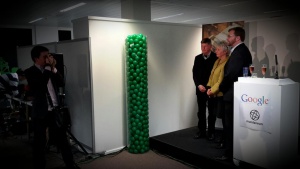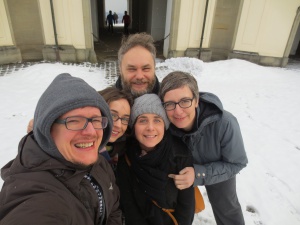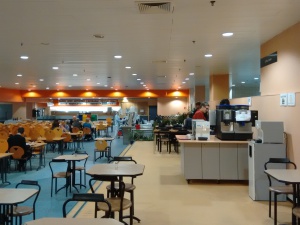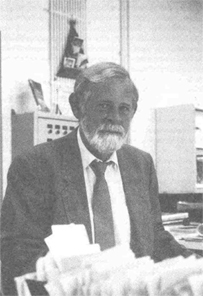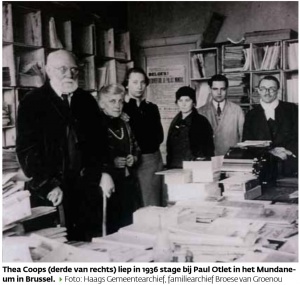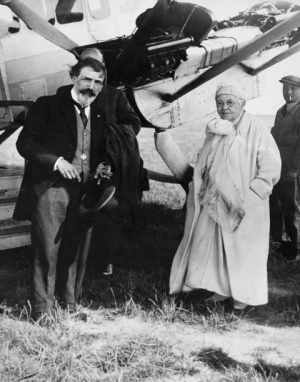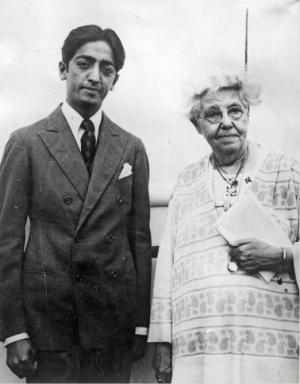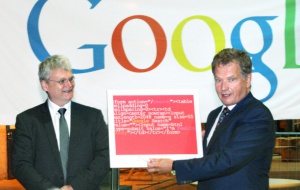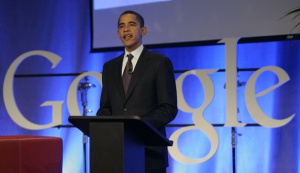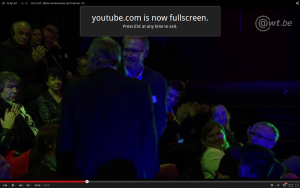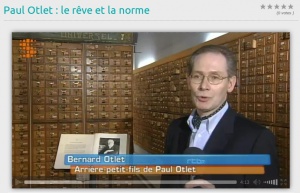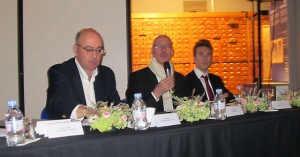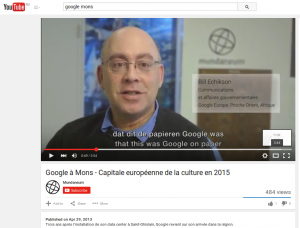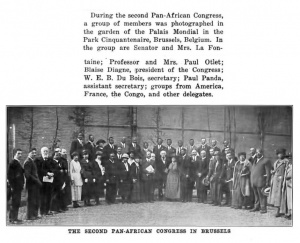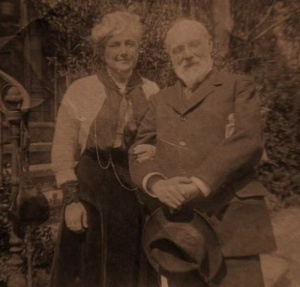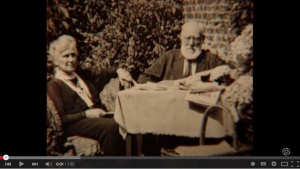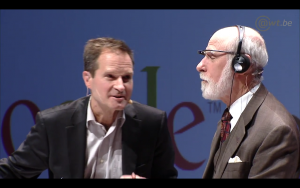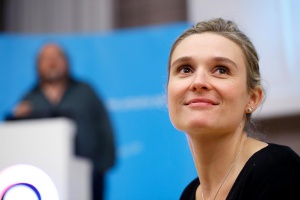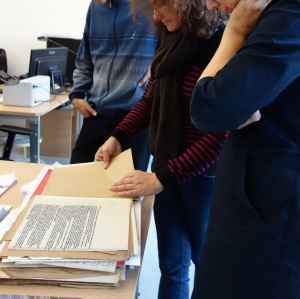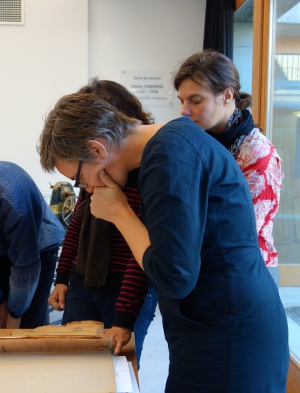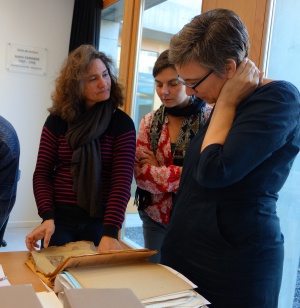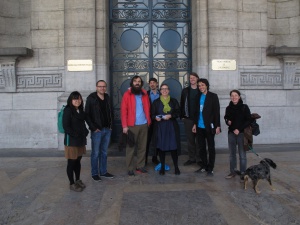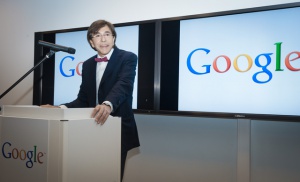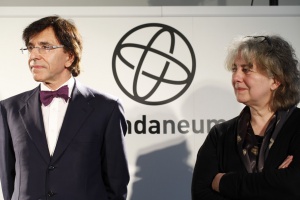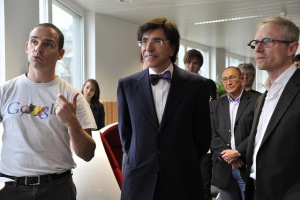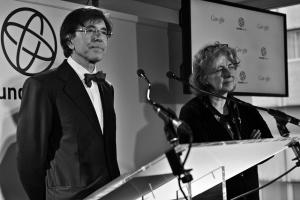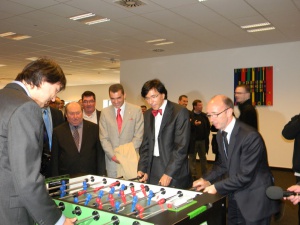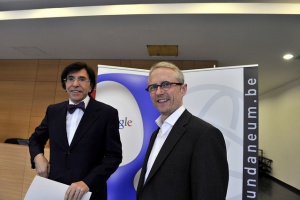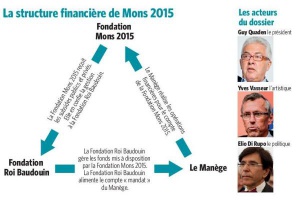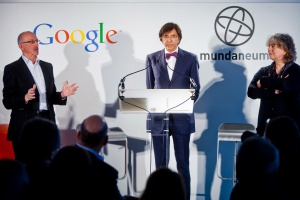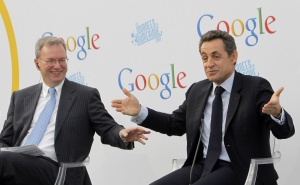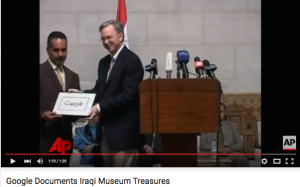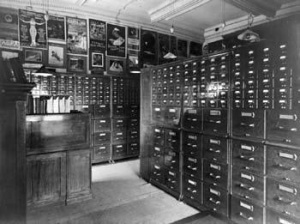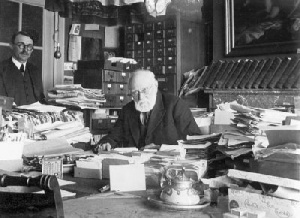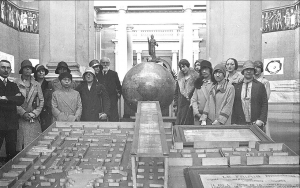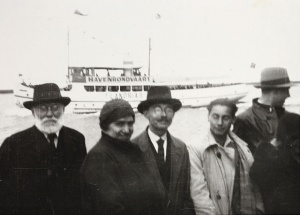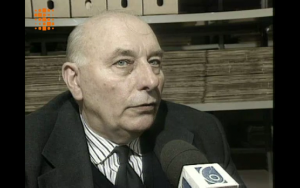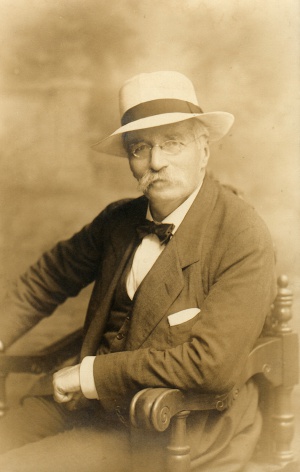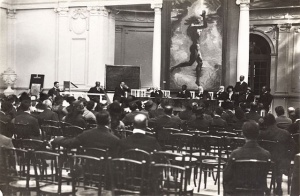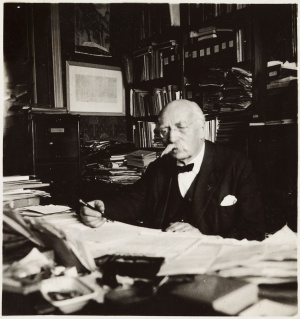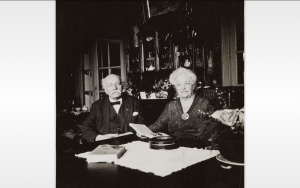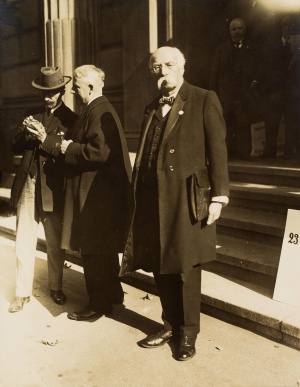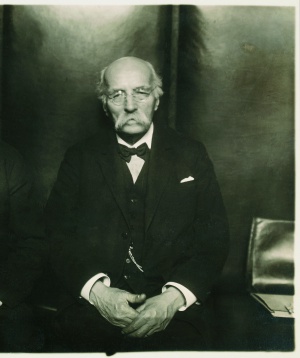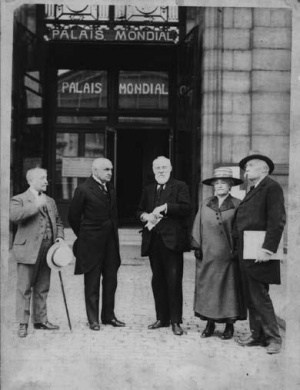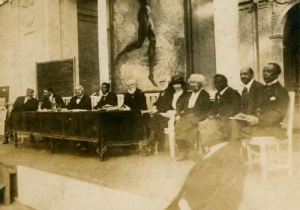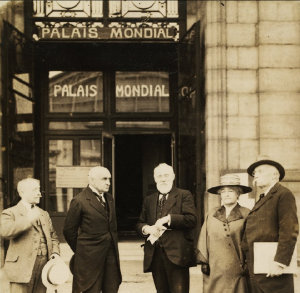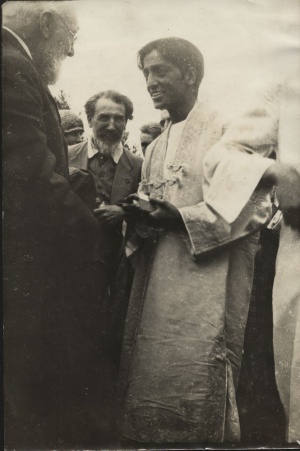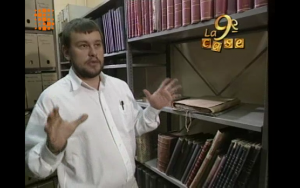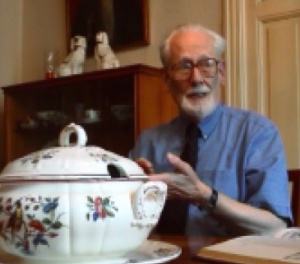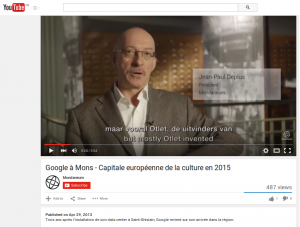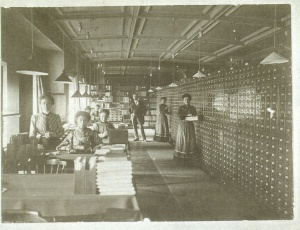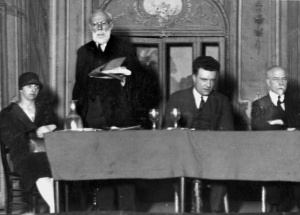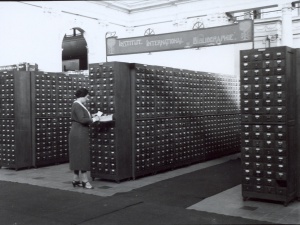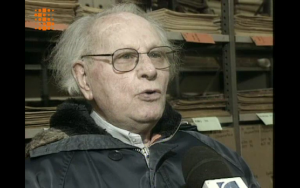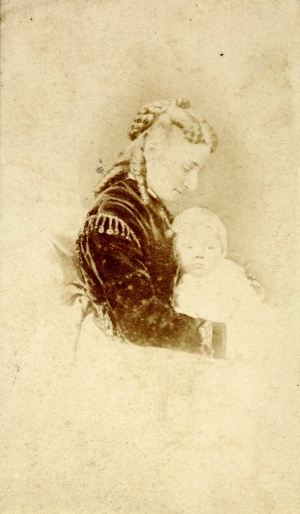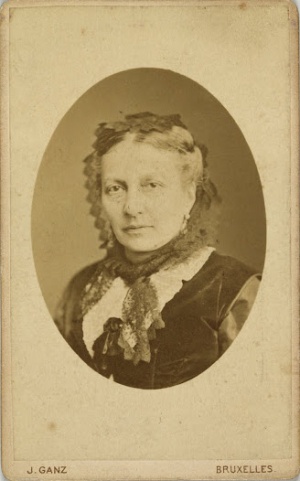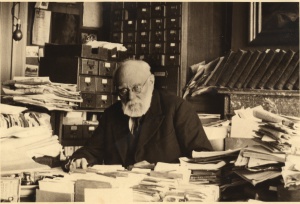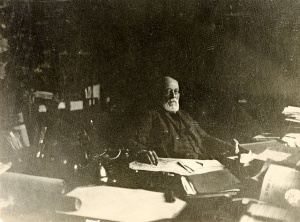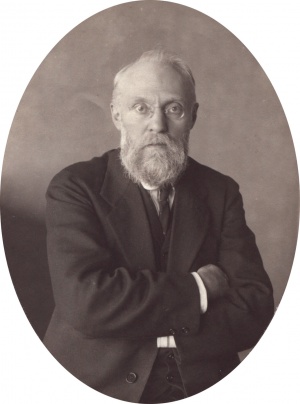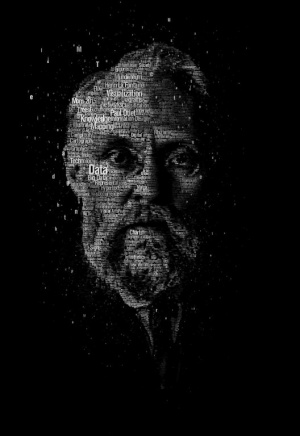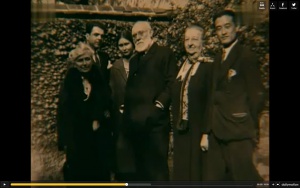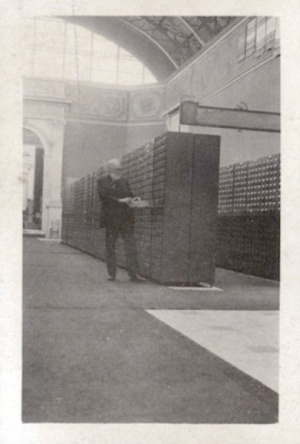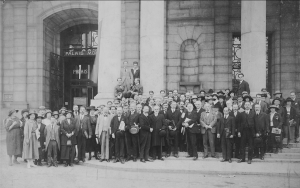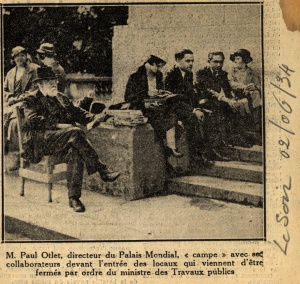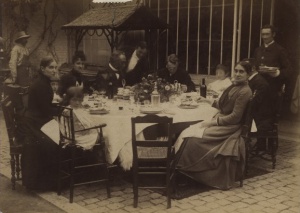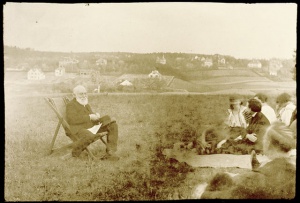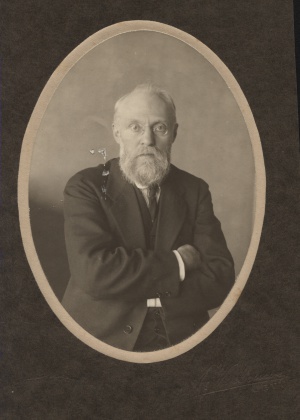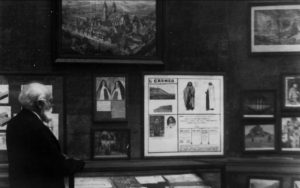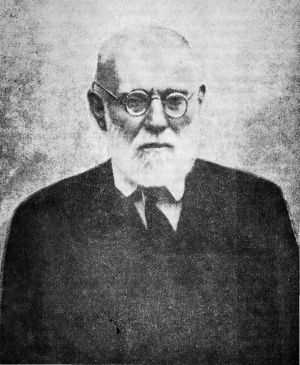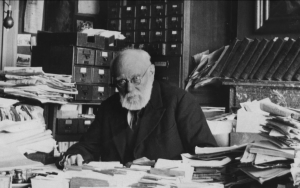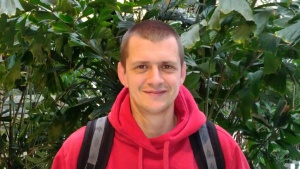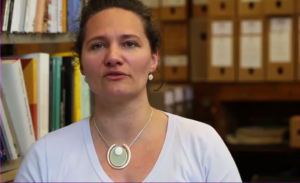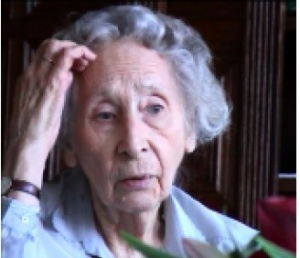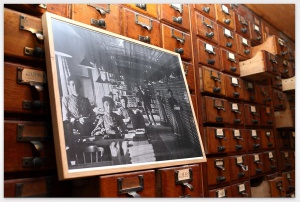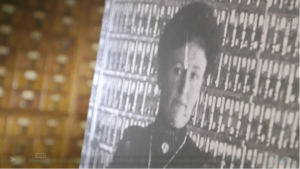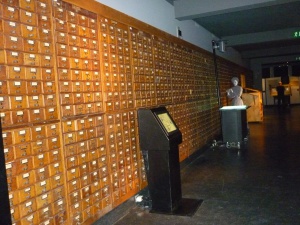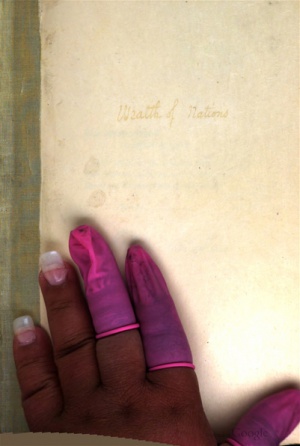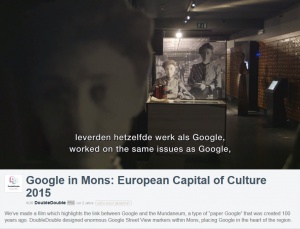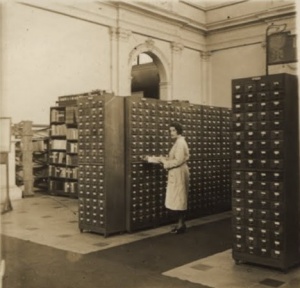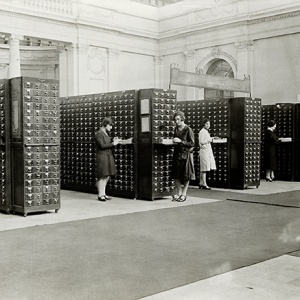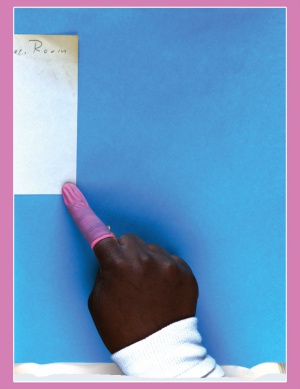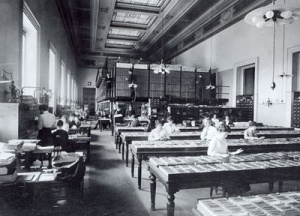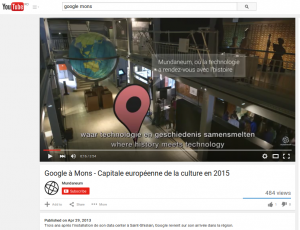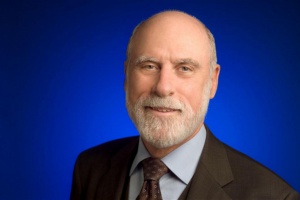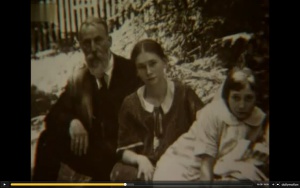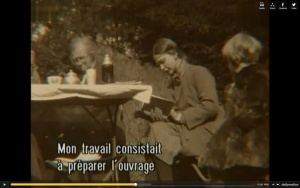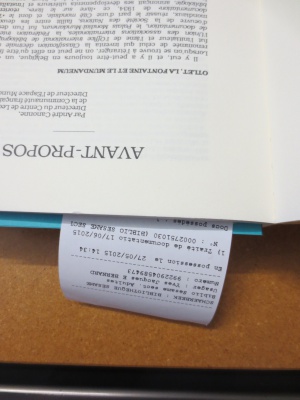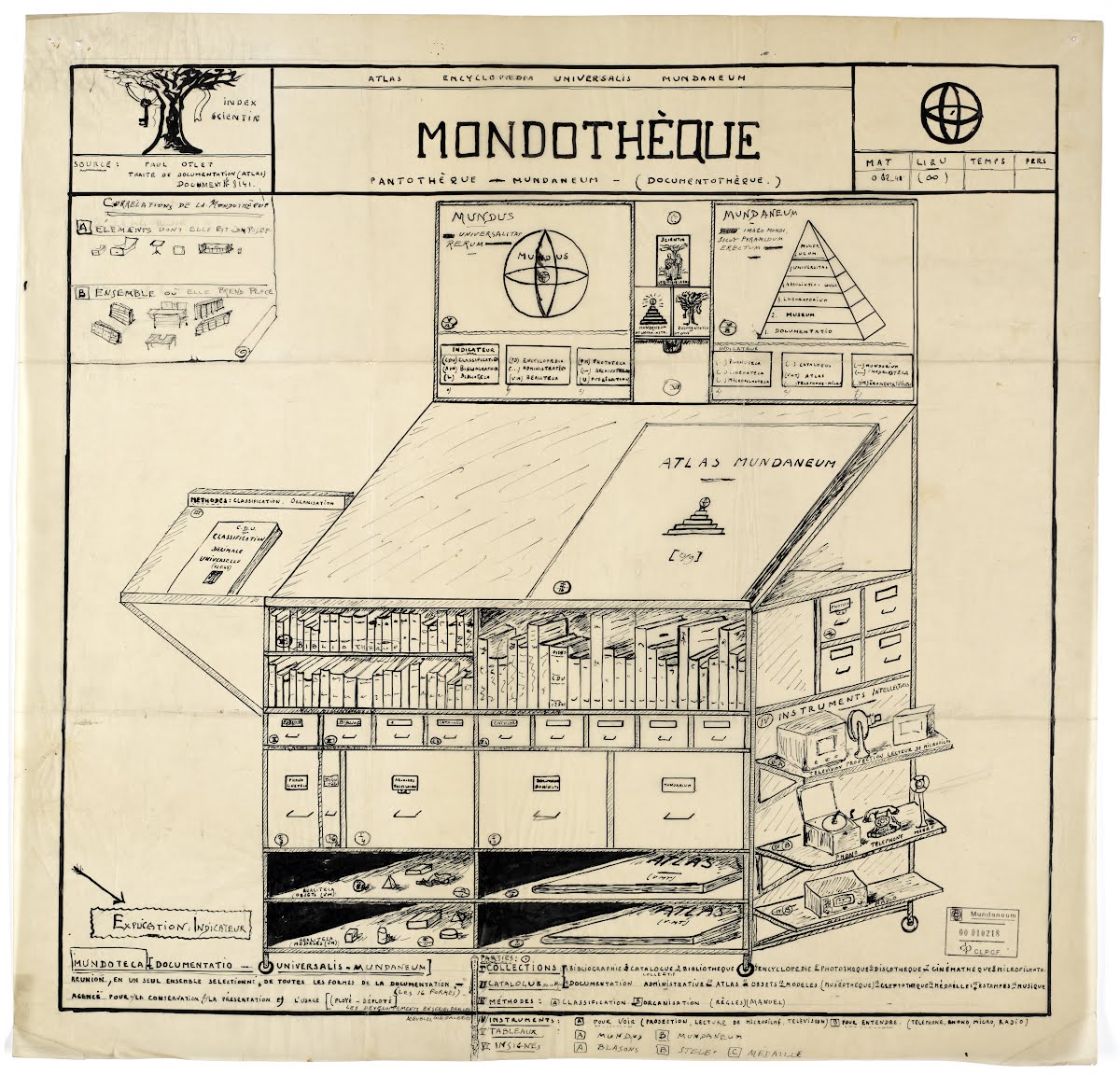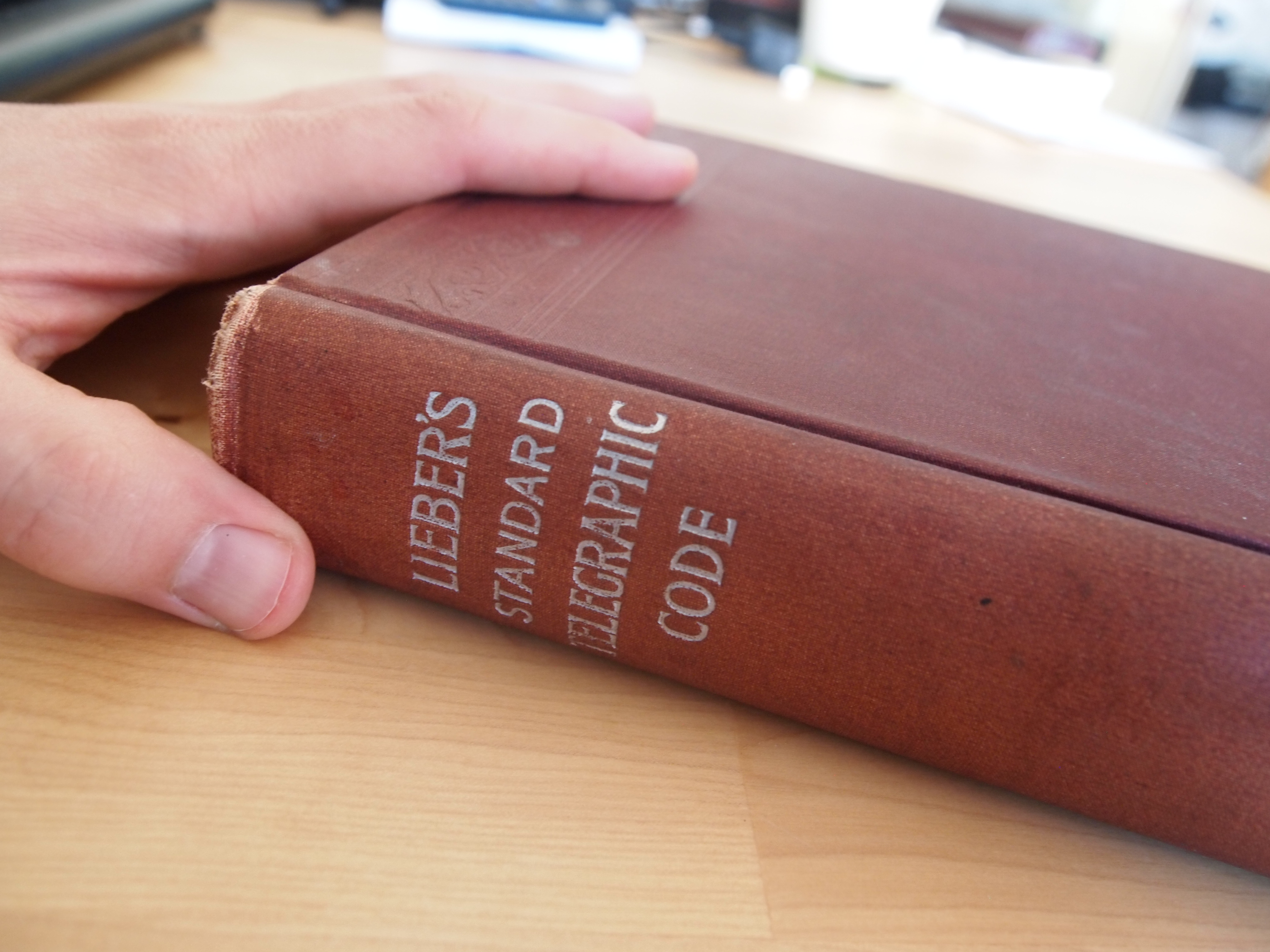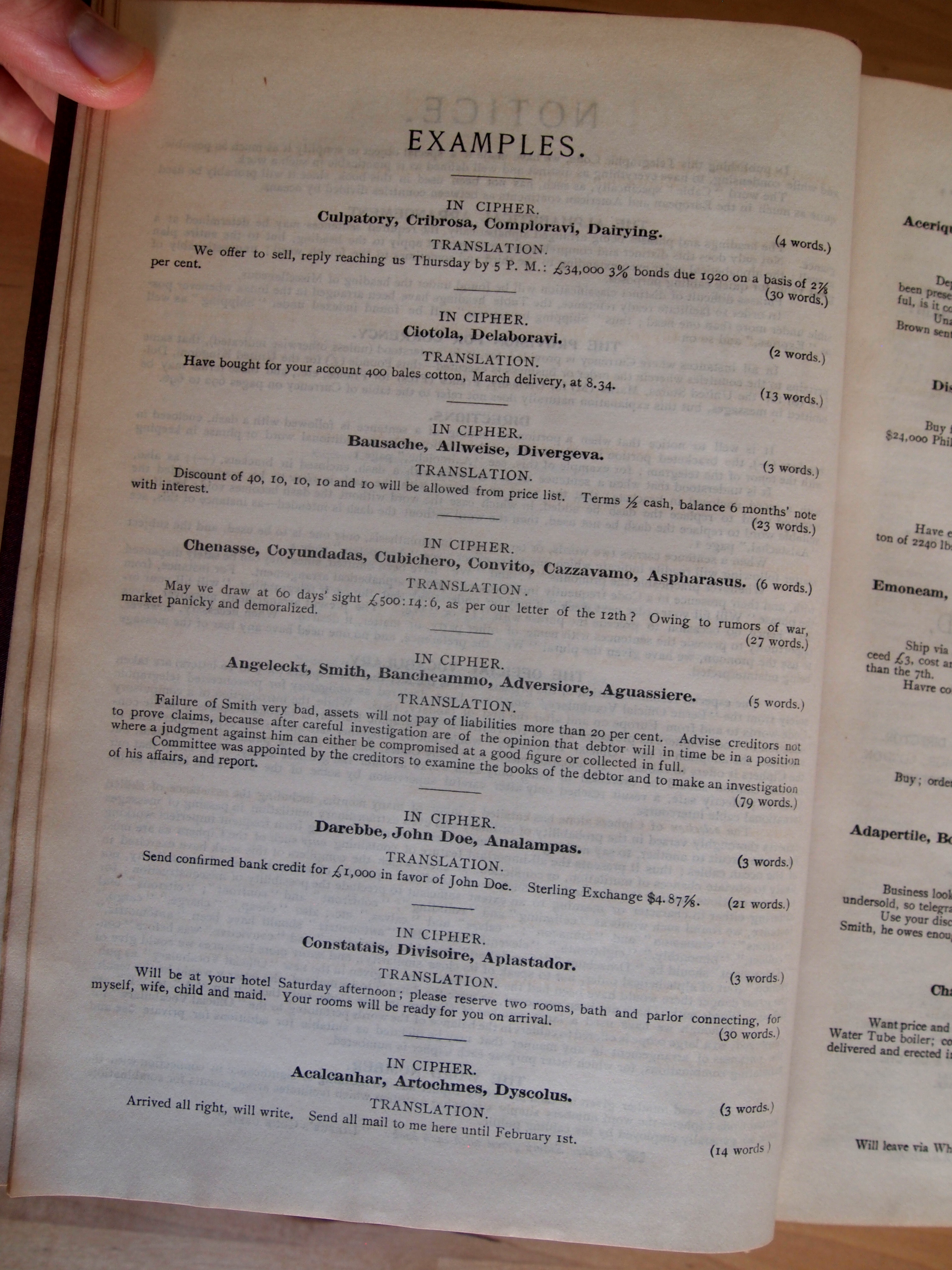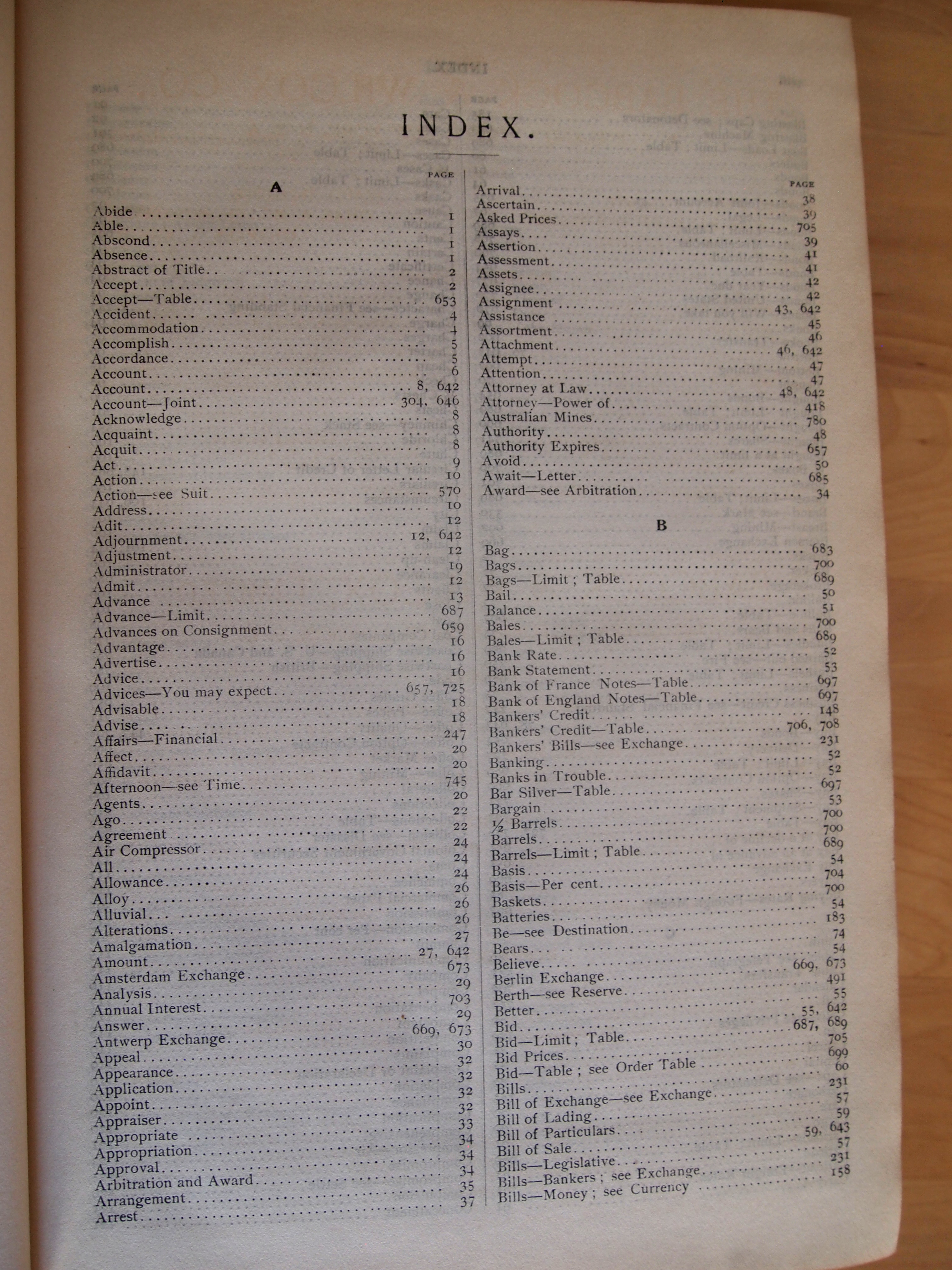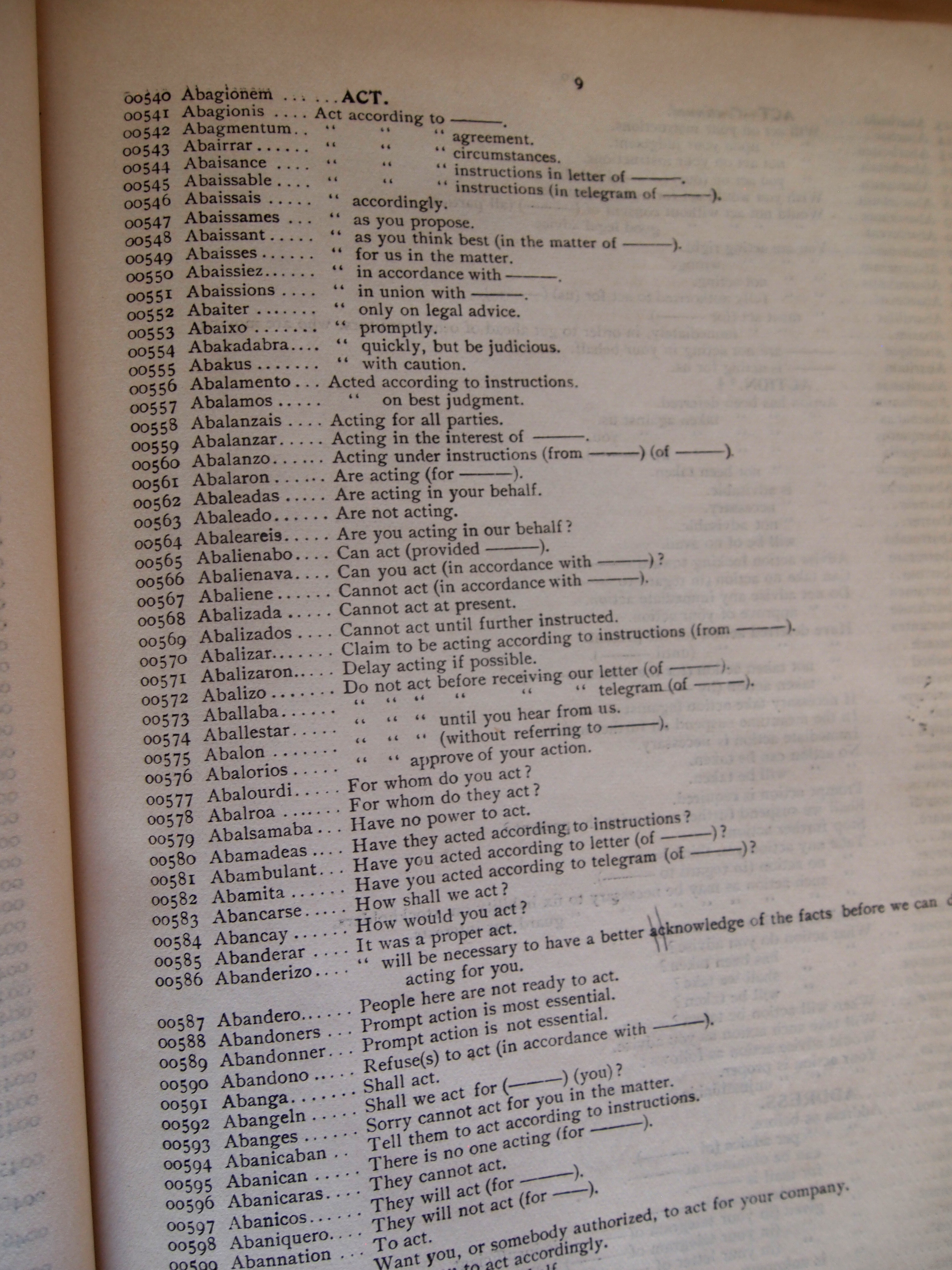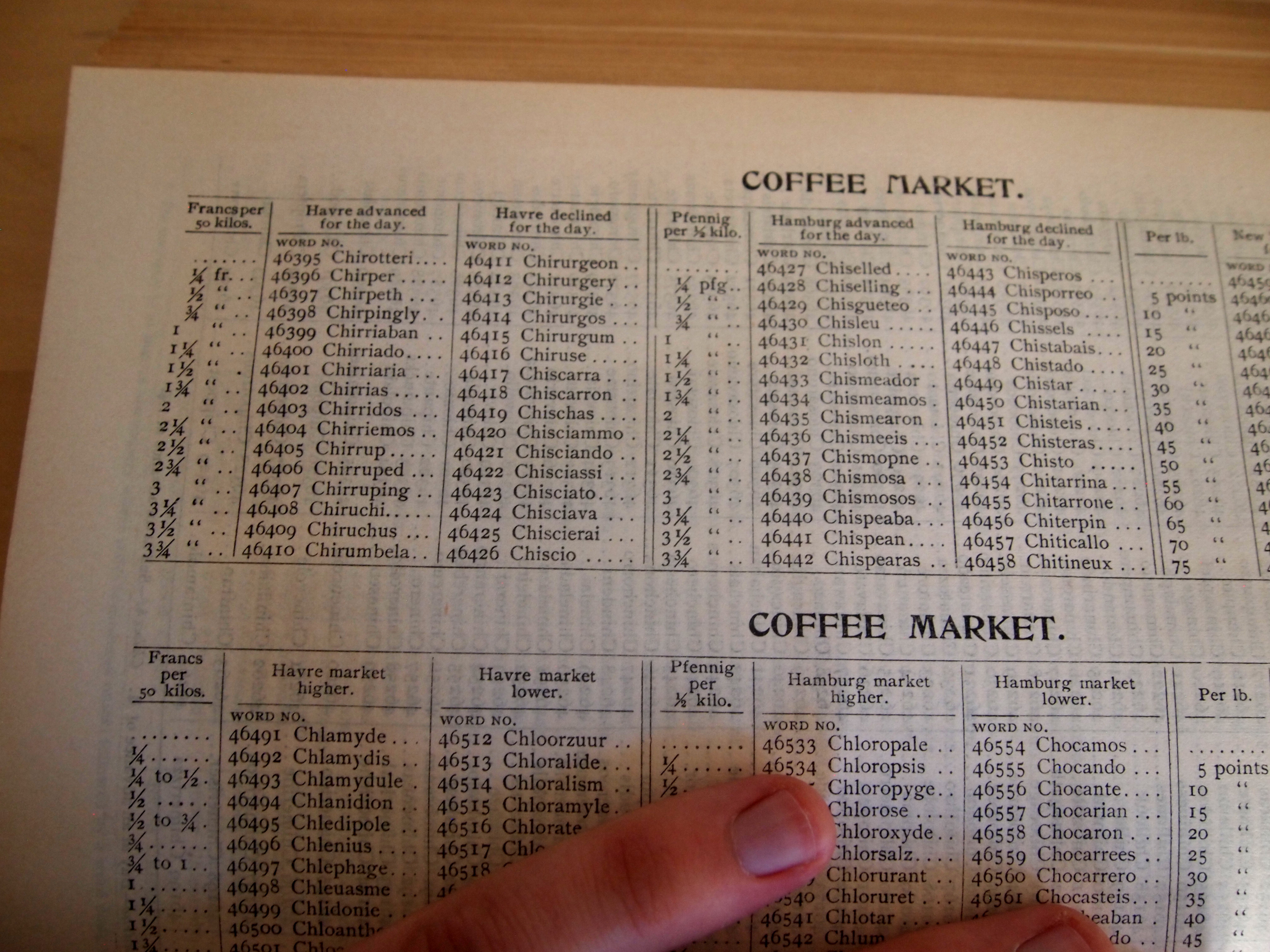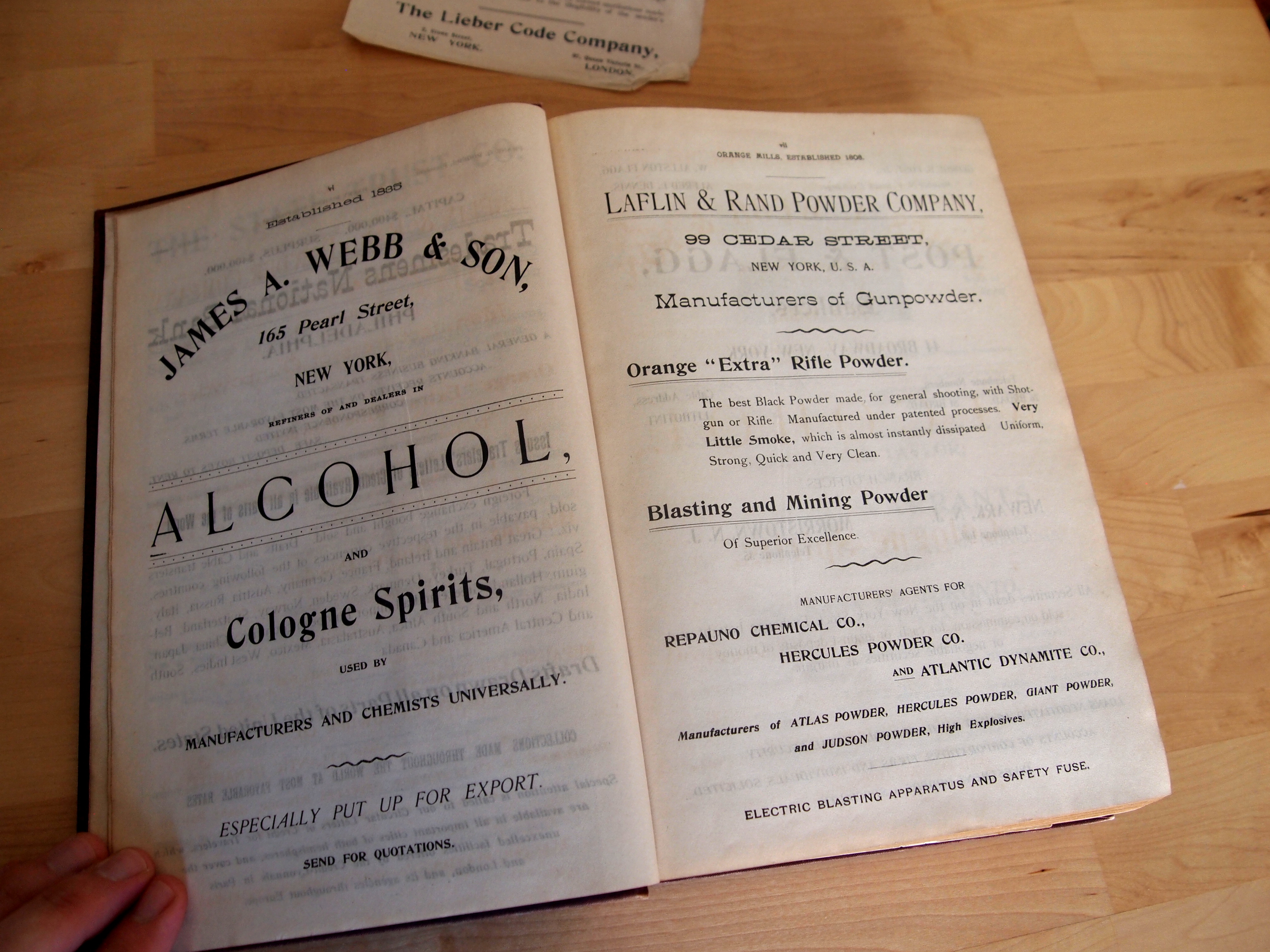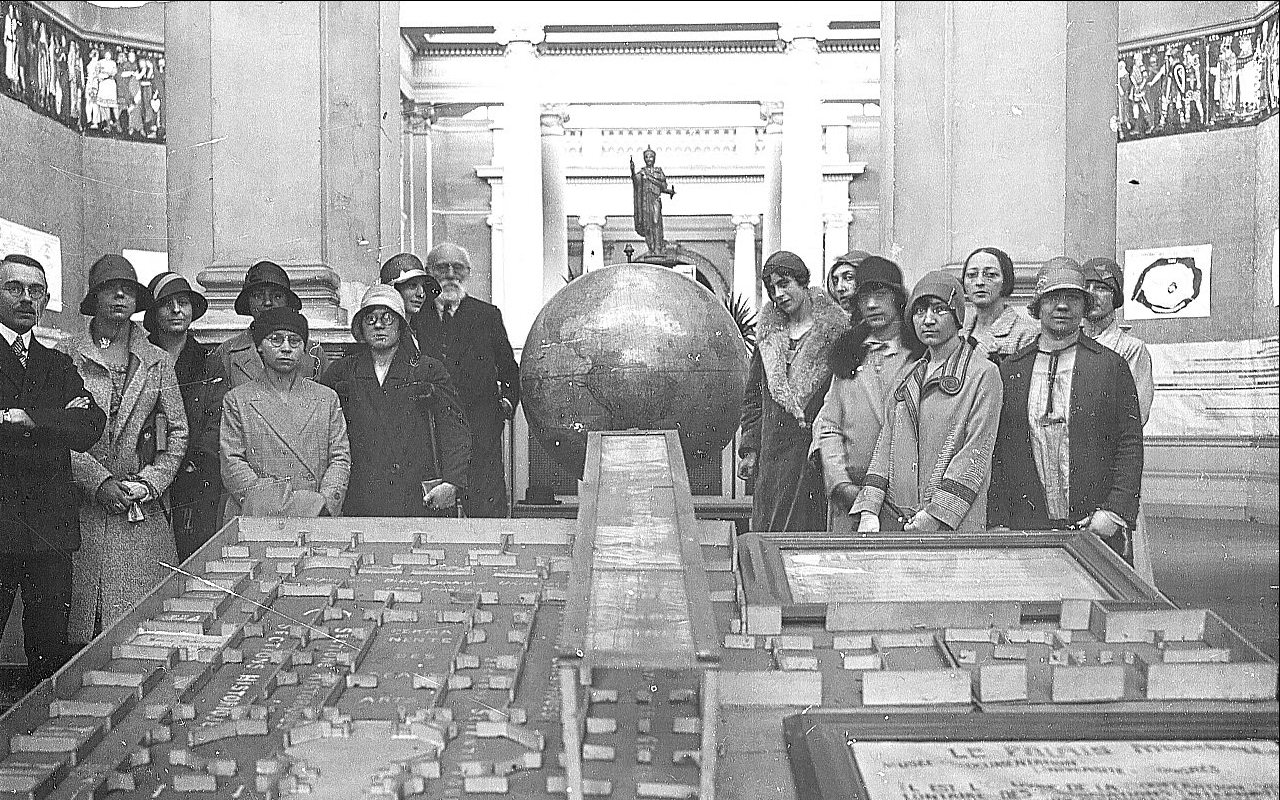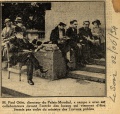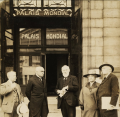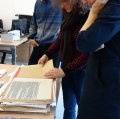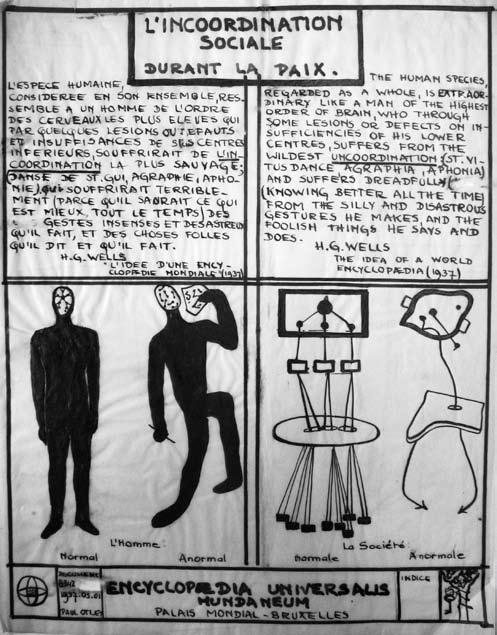Difference between revisions of "The radiated book"
From Mondothèque
(→Special:DisambiguationPages) |
|||
| Line 59: | Line 59: | ||
{{:A Pre-emptive History of the Google Cultural Institute}} | {{:A Pre-emptive History of the Google Cultural Institute}} | ||
| − | === [[Special: | + | === [[Special:Disambiguation]] === |
== Location, location, location == | == Location, location, location == | ||
Revision as of 14:40, 26 February 2016
Mondothèque: a radiated book
Property:Person (agents + actors)
Introduction
Femke Snelting
This Radiated Book started three years ago with an e-mail from the Mundaneum archive center in Mons. It announced that Elio di Rupo, then prime minister of Belgium, was about to sign a collaboration agreement between the archive center and Google. The newsletter cited an article in the French newspaper Le Monde that coined the Mundaneum as 'Google on paper' [1]. It was our first encounter with many variations on the same theme.
The former mining area around Mons is also where Google has installed its largest datacenter in Europe, a result of negotiations by the same Di Rupo[2]. Due to the re-branding of Paul Otlet as ‘founding father of the Internet’, Otlet's oeuvre finally started to receive international attention. Local politicians wanting to transform the industrial heartland into a home for The Internet Age seized the moment and made the Mundaneum a central node in their campaigns. Google — grateful for discovering its posthumous francophone roots — sent chief evangelist Vint Cerf to the Mundaneum. Meanwhile, the archive center allowed the company to publish hundreds of documents on the website of Google Cultural Institute.
While the visual resemblance between a row of index drawers and a server park might not be a coincidence, it is something else to conflate the type of universalist knowledge project imagined by Paul Otlet and Henri Lafontaine with the enterprise of the search giant. The statement 'Google on paper' acted as a provocation, evoking other cases in other places where geographically situated histories are turned into advertising slogans, and cultural infrastructures pushed into the hands of global corporations.
An international band of artists, archivists and activists set out to unravel the many layers of this mesh. The direct comparison between the historical Mundaneum project and the mission of Alphabet Inc[3] speaks of manipulative simplification on multiple levels, but to de-tangle its implications was easier said than done. Some of us were drawn in by misrepresentations of the oeuvre of Otlet himself, others felt the need to give an account of its Brussels' roots, to re-insert the work of maintenance and caretaking into the his/story of founding fathers, or joined out of concern with the future of cultural institutions and libraries in digital times.
We installed a Semantic MediaWiki and named it after the Mondothèque, a device imagined by Paul Otlet in 1934. The wiki functioned as an online repository and frame of reference for the work that was developed through meetings, visits and presentations[4]. For Otlet, the Mondothèque was to be an 'intellectual machine': at the same time archive, link generator, writing desk, catalog and broadcast station. Thinking the museum, the library, the encyclopedia, and classificatory language as a complex and interdependent web of relations, Otlet imagined each element as a point of entry for the other. He stressed that responses to displays in a museum involved intellectual and social processes that where different from those involved in reading books in a library, but that one in a sense entailed the other. [5]. The dreamed capacity of his Mondothèque was to interface scales, perspectives and media at the intersection of all those different practices. For us, by transporting a historical device into the future, it figured as a kind of thinking machine, a place to analyse historical and social locations of the Mundaneum project, a platform to envision our persistent interventions together. The speculative figure of Mondothèque enabled us to begin to understand the situated formations of power around the project, and allowed us to think through possible forms of resistance. [6]
The wiki at http://mondotheque.be grew into a labyrinth of images, texts, maps and semantic links, tools and vocabularies. MediaWiki is a Free software infrastructure developed in the context of Wikipedia and comes with many assumptions about the kind of connections and practices that are desirable. We wanted to work with Semantic extensions specifically because we were interested in the way The Semantic Web[7] seemed to resemble Otlet's Universal Decimal Classification system. At many moments we felt ourselves going down rabbit-holes of universal completeness, endless categorisation and nauseas of scale. It made the work at times uncomfortable, messy and unruly, but it allowed us to do the work of unravelling in public, mixing political urgency with poetic experiments.
This Radiated Book was made because we wanted to create a moment, an incision into that radiating process that allowed us to invite many others a look at the interrelated materials without the need to provide a conclusive document. As a salute to Otlet's ever expanding Radiated Library, we decided to use the MediaWiki installation to write, edit and generate the publication which explains some of the welcome anomalies on the very pages of this book.
The four chapters that we propose each mix fact and fiction, text and image, document and catalogue. In this way, process and content are playing together and respond to the specific material entanglements that we encountered. Mondotheque, and as a consequence this Radiated book, is a multi-threaded, durational, multi-scalar adventure that in some way diffracts the all-encompassing ambition that the 19th century Utopia of Mundaneum stood for.
Embedded hierarchies addresses how classification systems, and the dream of their universal application actually operate. It brings together contributions that are concerned with knowledge infrastructures at different scales, from disobedient libraries, institutional practices of the digital archive, meta-data structures to indexing as a pathological condition.
Disambiguation dis-entangles some of the similarities that appear around the heritage of Paul Otlet. Through a close-reading of seemingly similar biographies, terms and vocabularies it re-locates ambiguity to other places.
Location, location, location is an account of geo-political layers at work. Following the itinerant archive of Mundaneum through the capital of Europe, we encounter local, national and global Utopias that in turn leave their imprint on the way the stories play out. From the hyperlocal to the global, this chapter traces patterns in the physical landscape.
Cross-readings consists of lists, image collections and other materials that make connections emerge between historical and contemporary readings, unearthing possible spiritual or mystical underpinnings of the Mundaneum, and transversal inclusions of the same elements in between different locations.
The point of modest operations such as Mondothèque is to build the collective courage to persist in demanding access to both the documents and the intellectual and technological infrastructures that interface and mediate them. Exactly because of the urgency of the situation, where the erosion of public institutions has become evident, and all forms of communication seem to feed into neo-liberal agendas eventually, we should resist simplifications and find the patience to build a relation to these histories in ways that makes sense. It is necessary to go beyond the current techno-determinist paradigm of knowledge production, and for this, imagination is indispensable.
Embedded hierarchies
Une lecture-écriture du livre sur le livre.
unité
211 3. Le Biblion.
Il y a désormais un terme générique (Biblion ou Bibliogramme ou Document) qui couvre à la fois toutes les espèces : volumes, brochures, revues, articles, cartes, diagrammes, photographies, estampes, brevets, statistiques, voire même disques phonographiques, verres ou films cinématographiques.Le « Biblion » sera pour nous l’unité intellectuelle et abstraite mais que l’on peut retrouver concrètement et réellement mais revêtue de modalités diverses.Dans le cosmos (ensemble des choses) le livre ou Document prend place parmi les choses corporelles (non incorporelles), artificielles (non naturelles), et ayant une utilité intellectuelle (non matérielle).Le Livre est un moyen de produire des utilités intellectuelles.212.4 Unité, multiples et sous-multiples
L’unité physique, matière du document, est marquée soit par la continuité matérielle de sa surface (ex. : la surface d’une lettre, d’un journal), soit par un lien matériel entre plusieurs surfaces (ex. : les feuilles reliées d’un livre), soit par un lien immatériel (ex. : les divers tomes d’un même ouvrage).L’unité intellectuelle est la pensée.Comme en toutes choses, on peut distinguer aussi dans le document : 1° l’unité ; 2° les parties ; 3° leur totalité ; 4° une pluralité d’unités ; 5° la totalité des unités.
On a vu précédemment ce qu’on peut considérer comme unité intellectuelle. Il y a des multiples et sous multiples des unités matérielles et intellectuelles.Toute chose considérée dans son ordre propre est placée au degré d’une échelle dont les deux extrémités sont le néant d’une part et la totalité d’autre part. Dans l’échelle de la série ainsi établie, on choisit plus ou moins arbitrairement une unité d’où l’on puisse procéder dans les deux directions montante et descendante. En ce qui concerne la Documentation, l’unité sera le livre, ses multiples seront les ensembles formés par le livre tels que les collections (bibliothèques) et ses sous-multiples seront des divisions telles que ses parties (chapitres, etc.).411.51 Unité (Complexité)
L’Unité consiste à concevoir comme un seul ensemble toute la Documentation et à tendre constamment à y ramener tout ce qui aurait tendance de s’en éloigner.Présentation
Comme il ne saurait s’agir d’une standardisation et d’une mécanisation totales du travail C’est à chacun à composer un « Manuel de Documentation » car celui-ci, s’il contient de nombreuses formules, n’a cependant en réalité rien d’un Formulaire.biblion
Le grec a donné le mot biblion, le latin le mot liber. On a fait de l'un Bibliographie, bibliologie, Bibliophilie, Bibliothèque; de l'autre Livre, Livresque, Libriairie[8]
111 Notion.
1. Livre (Biblion ou Document ou Gramme) est le terme conventionnel employé ici pour exprimer toute espèce de documents. Il comprend non seulement le livre proprement dit, manuscrit ou imprimé, mais les revues, les journaux, les écrits et reproductions graphiques de toute espèce, dessins, gravures, cartes, schémas, diagrammes, photographies, etc. Livre, éléments servant à indiquer ou reproduire une pensée envisagée sous n’importe quelle forme.
211 3. Le Biblion.
Il y a désormais un terme générique (Biblion ou Bibliogramme ou Document) qui couvre à la fois toutes les espèces : volumes, brochures, revues, articles, cartes, diagrammes, photographies, estampes, brevets, statistiques, voire même disques phonographiques, verres ou films cinématographiques.Le « Biblion » sera pour nous l’unité intellectuelle et abstraite mais que l’on peut retrouver concrètement et réellement mais revêtue de modalités diverses.Dans le cosmos (ensemble des choses) le livre ou Document prend place parmi les choses corporelles (non incorporelles), artificielles (non naturelles), et ayant une utilité intellectuelle (non matérielle).Le Livre est un moyen de produire des utilités intellectuelles.
411.1 Les documents.
2° L’Image (Icone). Elle reproduit la réalité. On distingue la reproduction directe de la réalité. Elle s’opère par l’un des procédés suivants : tableau, aquarelle (en couleurs) isolé ou mobile ou fixe (fresque), plafond, encadrement dans une paroi dans un objet, dessin (noir ou couleur), gravure, photographie, sculpture.Les écrits (Biblion). On distingue qu’ils sont ou relatifs directement à la réalité ou bien relatifs à une image, et alors ils sont : a) ou relatifs à une reproduction de la réalité, soit tableau, dessin, gravure, photographie, sculpture ; b) ou relatifs à une reproduction d’une reproduction faite à son tour par tableau, dessin, gravure, photographie ou sculpture.1. Réalité.2. Reproduction de la réalité.
3. Écrit sur une reproduction de la réalité.1. Choses elles-mêmes.
2. La mention de chose dans la classification.
3. Le catalogue général inventoriant les choses en elles-mêmes ou appartenant à des collections déterminées.
4. Le catalogue (général ou particulier) de documents relatifs aux choses. 1. Auteur de l’original.
2. Auteur de la reproduction.
111 Notion.
1. Livre (Biblion ou Document ou Gramme) est le terme conventionnel employé ici pour exprimer toute espèce de documents. Il comprend non seulement le livre proprement dit, manuscrit ou imprimé, mais les revues, les journaux, les écrits et reproductions graphiques de toute espèce, dessins, gravures, cartes, schémas, diagrammes, photographies, etc. Livre, éléments servant à indiquer ou reproduire une pensée envisagée sous n’importe quelle forme.211 3. Le Biblion.
Il y a désormais un terme générique (Biblion ou Bibliogramme ou Document) qui couvre à la fois toutes les espèces : volumes, brochures, revues, articles, cartes, diagrammes, photographies, estampes, brevets, statistiques, voire même disques phonographiques, verres ou films cinématographiques.Le « Biblion » sera pour nous l’unité intellectuelle et abstraite mais que l’on peut retrouver concrètement et réellement mais revêtue de modalités diverses.Dans le cosmos (ensemble des choses) le livre ou Document prend place parmi les choses corporelles (non incorporelles), artificielles (non naturelles), et ayant une utilité intellectuelle (non matérielle).Le Livre est un moyen de produire des utilités intellectuelles.411.1 Les documents.
2° L’Image (Icone). Elle reproduit la réalité. On distingue la reproduction directe de la réalité. Elle s’opère par l’un des procédés suivants : tableau, aquarelle (en couleurs) isolé ou mobile ou fixe (fresque), plafond, encadrement dans une paroi dans un objet, dessin (noir ou couleur), gravure, photographie, sculpture.Les écrits (Biblion). On distingue qu’ils sont ou relatifs directement à la réalité ou bien relatifs à une image, et alors ils sont : a) ou relatifs à une reproduction de la réalité, soit tableau, dessin, gravure, photographie, sculpture ; b) ou relatifs à une reproduction d’une reproduction faite à son tour par tableau, dessin, gravure, photographie ou sculpture.1. Réalité.2. Reproduction de la réalité.
3. Écrit sur une reproduction de la réalité.1. Choses elles-mêmes.
2. La mention de chose dans la classification.
3. Le catalogue général inventoriant les choses en elles-mêmes ou appartenant à des collections déterminées.
4. Le catalogue (général ou particulier) de documents relatifs aux choses. 1. Auteur de l’original.
2. Auteur de la reproduction.
coquille
222.11 Notion.
La disposition donnée à l’écriture sur le papier a quelque chose de fondamental. En principe on peut écrire normalement de gauche à droite et d’en dessus en dessous, mais l’inverse est possible. De droite à gauche, de bas en haut, on peut écrire et commencer par la première page à partir de l’extérieur ou par la page du milieu.En principe, l’écriture est linéaire, car elle suit l’énonciation des sons qui se succèdent dans le temps. La ligne a donc pris trois directions fondamentales : horizontale, verticale et retour. (Boustropheron).L’écriture pourrait-elle être transformée de simplement linéaire en surface et y aurait-il quelque parti à tirer d’une écriture plurilinéaire à la manière des partitions musicales ou des notations chimiques ? Sur des lignes superposées, ayant même direction, ou sur des lignes prenant d’un point central des directions diverses seraient écrits les développements d’un exposé qui se succèdent aujourd’hui linéairement.
Errata
ANNEXE ERRATA : ( Page omise ).
373 bis.222.11 Notion.
La disposition donnée à l’écriture sur le papier a quelque chose de fondamental. En principe on peut écrire normalement de gauche à droite et d’en dessus en dessous, mais l’inverse est possible. De droite à gauche, de bas en haut, on peut écrire et commencer par la première page à partir de l’extérieur ou par la page du milieu.En principe, l’écriture est linéaire, car elle suit l’énonciation des sons qui se succèdent dans le temps. La ligne a donc pris trois directions fondamentales : horizontale, verticale et retour. (Boustropheron).L’écriture pourrait-elle être transformée de simplement linéaire en surface et y aurait-il quelque parti à tirer d’une écriture plurilinéaire à la manière des partitions musicales ou des notations chimiques ? Sur des lignes superposées, ayant même direction, ou sur des lignes prenant d’un point central des directions diverses seraient écrits les développements d’un exposé qui se succèdent aujourd’hui linéairement.Errata
ANNEXE ERRATA : ( Page omise ).
373 bis.A curriculum in amateur librarianship
Tomislav Medak & Marcell Mars (Public Library project)
Public library, a political genealogy
Public libraries have historically achieved as an institutional space of exemption from the commodification and privatization of knowledge. A space where works of literature and science are housed and made accessible for the education of every member of society regardless of their social or economic status. If, as a liberal narrative has it, education is a prerequisite for full participation in a body politic, it is in this narrow institutional space that citizenship finds an important material base for its universal realization.
The library as an institution of public access and popular literacy, however, did not develop before a series of transformations and social upheavals unfolded in the course of 18th and 19th century. These developments brought about a flood of books and political demands pushing the library to become embedded in an egalitarian and democratizing political horizon. The historic backdrop for these developments was the rapid ascendancy of the book as a mass commodity and the growing importance of the reading culture in the aftermath of the invention of the movable type print. Having emerged almost in parallel with capitalism, by the early 18th century the trade in books was rapidly expanding. While in the 15th century the libraries around the monasteries, courts and universities of Western Europe contained no more than 5 million manuscripts, the output of printing presses in the 18th century alone exploded to formidable 700 million volumes.[9] And while this provided a vector for the emergence of a bourgeois reading public and an unprecedented expansion of modern science, the culture of reading and Enlightenment remained largely a privilege of the few.
Two social upheavals would start to change that. On 2 November 1789 the French revolutionary National Assembly passed a decision to seize all library holdings from the Church and aristocracy. Millions of volumes were transferred to the Bibliothèque Nationale and local libraries across France. At the same time capitalism was on the rise, particularly in England. It massively displaced the impoverished rural population into growing urban centres, propelled the development of industrial production and, by the mid-19th century, introduced the steam-powered rotary press into the commercial production of books.Template loop detected: Amateur Librarian - A Course in Critical Pedagogy
Puisqu'il était de plus en plus facile de produire des livres en masse, les bibliothèques privées payantes, au service des catégories privilégiées de la société, ont commencé à se répandre. Ce phénomène a mis en relief la question de la classe dans la demande naissante pour un accès public aux livres.
After the failed attempt to introduce universal suffrage and end the system of political representation based on property entitlements through the Reform Act of 1832, the English Chartist movement started to open reading rooms and cooperative lending libraries that would quickly become a popular hotbed of social exchange between the lower classes. In the aftermath of the revolutionary upheavals of 1848, the fearful ruling classes finally consented to the demand for tax-financed public libraries, hoping that the access to literature and edification would after all help educate skilled workers that were increasingly in demand and ultimately hegemonize the working class for the benefits of capitalism's culture of self-interest and competition.[10]
Really useful knowledge
It's no surprise that the Chartists, reeling from a political defeat, had started to open reading rooms and cooperative lending libraries. The education provided to the proletariat and the poor by the ruling classes of that time consisted, indeed, either of a pious moral edification serving political pacification or of an inculcation of skills and knowledge useful to the factory owner. Even the seemingly noble efforts of the Society for the Diffusion of the Useful Knowledge, a Whig organization aimed at bringing high-brow learning to the middle and working classes in the form of simplified and inexpensive publications, were aimed at dulling the edge of radicalism of popular movements.[12]
These efforts to pacify the downtrodden masses pushed them to seek ways of self-organized education that would provide them with literacy and really useful knowledge – not applied, but critical knowledge that would allow them to see through their own political and economic subjection, develop radical politics and innovate shadow social institutions of their own. The radical education, reliant on meagre resources and time of the working class, developed in the informal setting of household, neighbourhood and workplace, but also through radical press and communal reading and discussion groups.[13]
The demand for really useful knowledge encompassed a critique of “all forms of ‘provided’ education” and of the liberal conception “that ‘national education’ was a necessary condition for the granting of universal suffrage.” Development of radical “curricula and pedagogies” formed a part of the arsenal of “political strategy as a means of changing the world.”[14]
Critical pedagogy
This is the context of the emergence of the public library. A historical compromise between a push for radical pedagogy and a response to dull its edge. And yet with the age of digitization, where one would think that the opportunities for access to knowledge have expanded immensely, public libraries find themselves increasingly limited in their ability to acquire and lend both digital and paper editions. It is a sign of our radically unequal times that the political emancipation finds itself on a defensive fighting again for this material base of pedagogy against the rising forces of privatization. Not only has mass education become accessible only under the condition of high fees, student debt and adjunct peonage, but the useful knowledge that the labour market and reproduction of the neoliberal capitalism demands has become the one and only rationale for education.
No wonder that over the last 6-7 years we have seen self-education, shadow libraries and amateur librarians emerge again to counteract the contraction of spaces of exemption that have been shrunk by austerity and commodity.
The project Public Library was initiated with the counteraction in mind. To help everyone learn to use simple tools to be able to act as an Amateur Librarian – to digitize, to collect, to share, to preserve books and articles that were unaffordable, unavailable, undesirable in the troubled corners of the Earth we hail from.
Amateur Librarian played an important role in the narrative of Public Library. And it seems it was successful. People easily join the project by 'becoming' a librarian using Calibre[15] and [let’s share books].[16] Other aspects of the Public Library narrative add a political articulation to that simple yet disobedient act. Public Library detects an institutional crisis in education, an economic deadlock of austerity and a domination of commodity logic in the form of copyright. It conjures up the amateur librarians’ practice of sharing books/catalogues as a relevant challenge against the convergence of that crisis, deadlock and copyright regime.
To understand the political and technological assumptions and further develop the strategies that lie behind the counteractions of amateur librarians, we propose a curriculum that is indebted to a tradition of critical pedagogy. Critical pedagogy is a productive and theoretical practice rejecting an understanding of educational process that reduces it to a technique of imparting knowledge and a neutral mode of knowledge acquisition. Rather, it sees the pedagogy as a broader “struggle over knowledge, desire, values, social relations, and, most important, modes of political agency”, “drawing attention to questions regarding who has control over the conditions for the production of knowledge.”[17]
Actuellement, aucune industrie ne montre plus d'asymétries au niveau du contrôle des conditions de production de la connaissance que celle de la publication académique. Refuser l'accès à des publications académiques excessivement chères pour beaucoup d'universités, en particulier dans l'hémisphère sud, contraste ostensiblement avec les profits énormes qu'un petit nombre d'éditeurs commerciaux tirent du travail bénévole de scientifiques qui écrivent, révisent et éditent des contributions et avec les prix exorbitants des souscriptions que les bibliothèques institutionnelles doivent payer.
FS: Hoe gaan jullie om met boeken en publicaties die al vanaf het begin digitaal zijn? DM: We kopen e-books en e-tijdschriften en maken die beschikbaar voor onderzoekers. Maar dat zijn hele andere omgevingen, omdat die content niet fysiek binnen onze muren komt. We kopen toegang tot servers van uitgevers of de aggregator. Die content komt nooit bij ons, die blijft op hun machines staan. We kunnen daar dus eigenlijk niet zoveel mee doen, behalve verwijzen en zorgen dat het evengoed vindbaar is als de print.
A curriculum
Public library is:
- free access to books for every member of society,
- library catalogue,
- librarian.
Template loop detected: Amateur Librarian - A Course in Critical Pedagogy
Tout en restant schématique en allant de la pratique immédiate, à la stratégie, la tactique et au registre réflectif de la connaissance, il existe des personnes et pratiques - non citées ici - desquelles nous imaginons pouvoir apprendre.
The first iteration of this curriculum could be either a summer academy rostered with our all-star team of librarians, designers, researchers and teachers, or a small workshop with a small group of students delving deeper into one particular aspect of the curriculum. In short it is an open curriculum: both open to educational process and contributions by others. We welcome comments, derivations and additions.
MODULE 1: Workflows
- from book to e-book
- digitizing a book on a book scanner
- removing DRM and converting e-book formats
- from clutter to catalogue
- managing an e-book library with Calibre
- finding e-books and articles on online libraries
- from reference to bibliography
- annotating in an e-book reader device or application
- creating a scholarly bibliography in Zotero
- from block device to network device
- sharing your e-book library on a local network to a reading device
- sharing your e-book library on the internet with [let’s share books]
- from private to public IP space
- using [let’s share books] & library.memoryoftheworld.org
- using logan & jessica
- using Science Hub
- using Tor
MODULE 2: Politics/tactics
- from developmental subordination to subaltern disobedience
- uneven development & political strategies
- strategies of the developed v strategies of the underdeveloped : open access v piracy
- from property to commons
- from property to commons
- copyright, scientific publishing, open access
- shadow libraries, piracy, custodians.online
- from collection to collective action
- critical pedagogy & education
- archive, activation & collective action
MODULE 3: Abstractions in action
- from linear to computational
- library & epistemology: catalogue, search, discovery, reference
- print book v e-book: page, margin, spine
- from central to distributed
- deep librarianship & amateur librarians
- network infrastructure(s)/topologies (ruling class studies)
- from factual to fantastic
- universe as library as universe
Reading List
- Mars, Marcell; Vladimir, Klemo. Download & How to: Calibre & [let’s share books]. Memory of the World (2014) https://www.memoryoftheworld.org/blog/2014/10/28/calibre-lets-share-books/
- Buringh, Eltjo; Van Zanden, Jan Luiten. Charting the “Rise of the West”: Manuscripts and Printed Books in Europe, A Long-Term Perspective from the Sixth through Eighteenth Centuries. The Journal of Economic History (2009) http://journals.cambridge.org/article_S0022050709000837
- Mattern, Shannon. Library as Infrastructure. Places Journal (2014) https://placesjournal.org/article/library-as-infrastructure/
- Antonić, Voja. Our beloved bookscanner. Memory of the World (2012) https://www.memoryoftheworld.org/blog/2012/10/28/our-beloved-bookscanner-2/
- Medak, Tomislav; Sekulić, Dubravka; Mertens, An. How to: Bookscanning. Memory of the World (2014) https://www.memoryoftheworld.org/blog/2014/12/08/how-to-bookscanning/
- Barok, Dušan. Talks/Public Library. Monoskop (2015) http://monoskop.org/Talks/Public_Library
- Custodians.online. In Solidarity with Library Genesis and Science Hub (2015) http://custodians.online
- Battles, Matthew. Library: An Unquiet History Random House (2014)
- Harris, Michael H. History of Libraries of the Western World. Scarecrow Press (1999)
- MayDay Rooms. Activation (2015) http://maydayrooms.org/activation/
- Krajewski, Markus. Paper Machines: About Cards & Catalogs, 1548-1929. MIT Press (2011) https://library.memoryoftheworld.org/b/PaRC3gldHrZ3MuNPXyrh1hM1meyyaqvhaWl-HTvr53NRjJ2k
For updates: https://www.zotero.org/groups/amateur_librarian_-_a_course_in_critical_pedagogy_reading_list
a bag but is language nothing of words
Michael Murtaugh
(language is nothing but a bag of words)
Bag of words
In information retrieval and other so-called machine-reading applications (such as text indexing for web search engines) the term "bag of words" is used to underscore how in the course of processing a text the original order of the words in sentence form is stripped away. The resulting representation is then a collection of each unique word used in the text, typically weighted by the number of times the word occurs.
Bag of words, also known as word histograms or weighted term vectors, are a standard part of the data engineer's toolkit. But why such a drastic transformation? The utility of "bag of words" is in how it makes text amenable to code, first in that it's very straightforward to implement the translation from a text document to a bag of words representation. More significantly, this transformation then opens up a wide collection of tools and techniques for further transformation and analysis purposes. For instance, a number of libraries available in the booming field of "data sciences" work with "high dimension" vectors; bag of words is a way to transform a written document into a mathematical vector where each "dimension" corresponds to the (relative) quantity of each unique word. While physically unimaginable and abstract (imagine each of Shakespeare's works as points in a 14 million dimensional space), from a formal mathematical perspective, it's quite a comfortable idea, and many complementary techniques (such as principle component analysis) exist to reduce the resulting complexity.
What's striking about a bag of words representation, given is centrality in so many text retrieval application is its irreversibility. Given a bag of words representation of a text and faced with the task of producing the original text would require in essence the "brain" of a writer to recompose sentences, working with the patience of a devoted cryptogram puzzler to draw from the precise stock of available words. While "bag of words" might well serve as a cautionary reminder to programmers of the essential violence perpetrated to a text and a call to critically question the efficacy of methods based on subsequent transformations, the expressions use seems in practice more like a badge of pride or a schoolyard taunt that would go: Hey language: you're nothing but a big BAG-OF-WORDS. Following this spirit of the term, "bag of words" celebrates a perfunctory step of "breaking" a text into a purer form amenable to computation, to stripping language of its silly redundant repetitions and foolishly contrived stylistic phrasings to reveal a purer inner essence.
Book of words
Lieber's Standard Telegraphic Code, first published in 1896 and republished in various updated editions through the early 1900s, is an example of one of several competing systems of telegraph code books. The idea was for both senders and receivers of telegraph messages to use the books to translate their messages into a sequence of code words which can then be sent for less money as telegraph messages were paid by the word. In the front of the book, a list of examples gives a sampling of how messages like: "Have bought for your account 400 bales of cotton, March delivery, at 8.34" can be conveyed by a telegram with the message "Ciotola, Delaboravi". In each case the reduction of number of transmitted words is highlighted to underscore the efficacy of the method. Like a dictionary or thesaurus, the book is primarily organized around key words, such as act, advice, affairs, bags, bail, and bales, under which exhaustive lists of useful phrases involving the corresponding word are provided in the main pages of the volume. [18]
[...] my focus in this chapter is on the inscription technology that grew parasitically alongside the monopolistic pricing strategies of telegraph companies: telegraph code books. Constructed under the bywords “economy,” “secrecy,” and “simplicity,” telegraph code books matched phrases and words with code letters or numbers. The idea was to use a single code word instead of an entire phrase, thus saving money by serving as an information compression technology. Generally economy won out over secrecy, but in specialized cases, secrecy was also important.[19]
In Katherine Hayles' chapter devoted to telegraph code books she observes how:
The interaction between code and language shows a steady movement away from a human-centric view of code toward a machine-centric view, thus anticipating the development of full-fledged machine codes with the digital computer. [20]
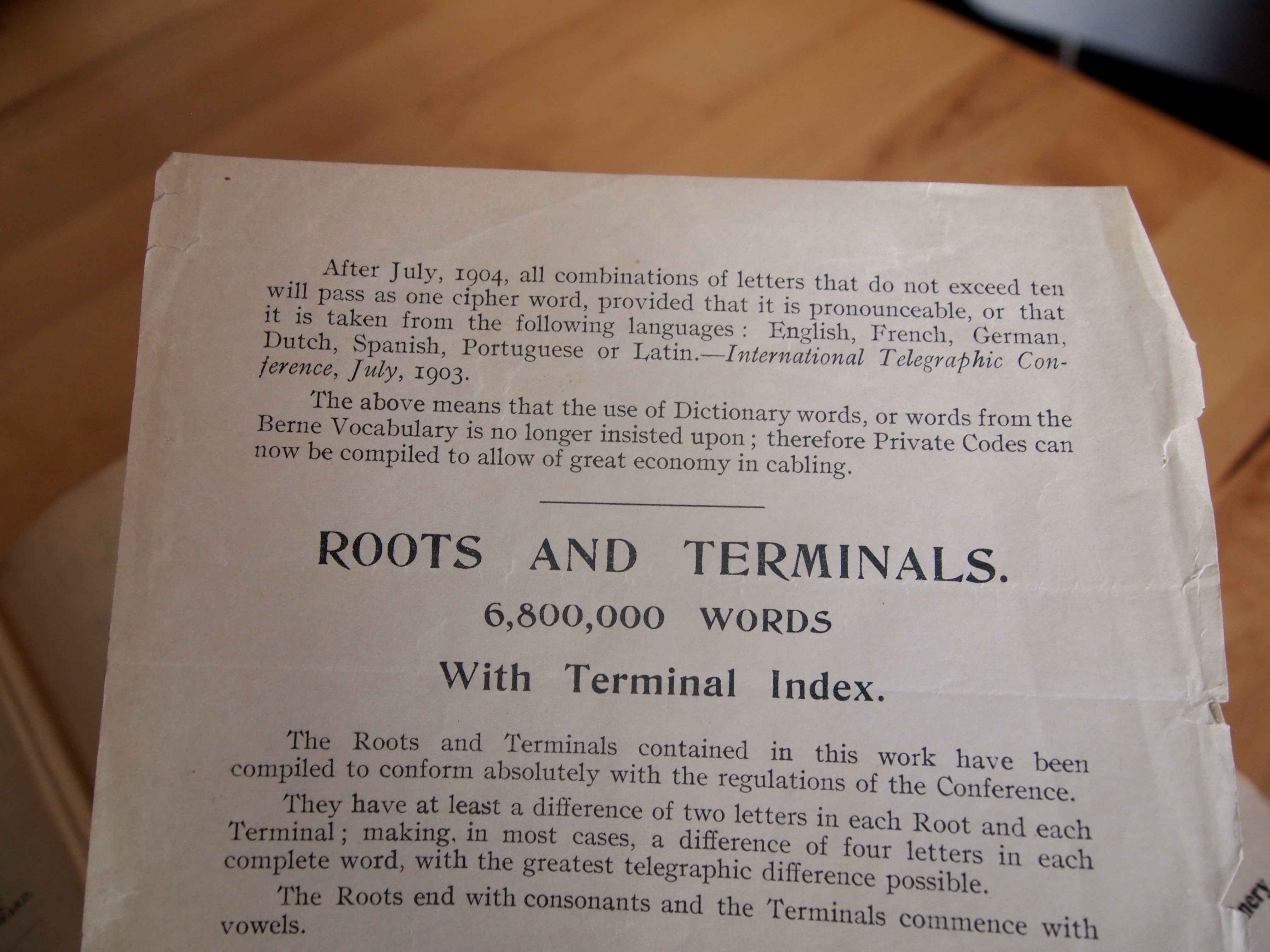
After July, 1904, all combinations of letters that do not exceed ten will pass as one cipher word, provided that it is pronounceable, or that it is taken from the following languages: English, French, German, Dutch, Spanish, Portuguese or Latin -- International Telegraphic Conference, July 1903 [21]
Conforming to international conventions regulating telegraph communication at that time, the stipulation that code words be actual words drawn from a variety of European languages (many of Lieber's code words are indeed arbitrary Dutch, German, and Spanish words) underscores this particular moment of transition as reference to the human body in the form of "pronounceable" speech from representative languages begins to yield to the inherent potential for arbitrariness in digital representation.
What telegraph code books do is remind us of is the relation of language in general to economy. Whether they may be economies of memory, attention, costs paid to a telecommunicatons company, or in terms of computer processing time or storage space, encoding language or knowledge in any form of writing is a form of shorthand and always involves an interplay with what one expects to perform or "get out" of the resulting encoding.
Along with the invention of telegraphic codes comes a paradox that John Guillory has noted: code can be used both to clarify and occlude. Among the sedimented structures in the technological unconscious is the dream of a universal language. Uniting the world in networks of communication that flashed faster than ever before, telegraphy was particularly suited to the idea that intercultural communication could become almost effortless. In this utopian vision, the effects of continuous reciprocal causality expand to global proportions capable of radically transforming the conditions of human life. That these dreams were never realized seems, in retrospect, inevitable. [22]
Far from providing a universal system of encoding messages in the English language, Lieber's code is quite clearly designed for the particular needs and conditions of its use. In addition to the phrases ordered by keywords, the book includes a number of tables of terms for specialized use. One table lists a set of words used to describe all possible permutations of numeric grades of coffee (Choliam = 3,4, Choliambos = 3,4,5, Choliba = 4,5, etc.); another table lists pairs of code words to express the respective daily rise or fall of the price of coffee at the port of Le Havre in increments of a quarter of a Franc per 50 kilos ("Chirriado = prices have advanced 1 1/4 francs"). From an archaeological perspective, the Lieber's code book reveals a cross section of the needs and desires of early 20th century business communication between the United States and its trading partners.
The advertisements lining the Liebers Code book further situate its use and that of commercial telegraphy. Among the many advertisements for banking and law services, office equipment, and alcohol are several ads for gun powder and explosives, drilling equipment and metallurgic services all with specific applications to mining. Extending telegraphy's formative role for ship-to-shore and ship-to-ship communication for reasons of safety, commercial telegraphy extended this network of communication to include those parties coordinating the "raw materials" being mined, grown, or otherwise extracted from overseas sources and shipped back for sale.
"Raw data now!"
Étant donné que les nouvelles formes modernistes et l'utilisation de matériaux propageaient l'abondance d'éléments décoratifs, Paul Otlet croyait en la possibilité du langage comme modèle de « données brutes », le réduisant aux informations essentielles et aux faits sans ambiguïté, tout en se débarrassant de tous les éléments inefficaces et subjectifs.
As new modernist forms and use of materials propagated the abundance of decorative elements, Otlet believed in the possibility of language as a model of 'raw data', reducing it to essential information and unambiguous facts, while removing all inefficient assets of ambiguity or subjectivity.
Tim Berners-Lee: [...] Make a beautiful website, but first give us the unadulterated data, we want the data. We want unadulterated data. OK, we have to ask for raw data now. And I'm going to ask you to practice that, OK? Can you say "raw"?
Audience: Raw.
Tim Berners-Lee: Can you say "data"?
Audience: Data.
TBL: Can you say "now"?
Audience: Now!
TBL: Alright, "raw data now"!
[...]
So, we're at the stage now where we have to do this -- the people who think it's a great idea. And all the people -- and I think there's a lot of people at TED who do things because -- even though there's not an immediate return on the investment because it will only really pay off when everybody else has done it -- they'll do it because they're the sort of person who just does things which would be good if everybody else did them. OK, so it's called linked data. I want you to make it. I want you to demand it. [23]
Un/Structured
As graduate students at Stanford, Sergey Brin and Lawrence (Larry) Page had an early interest in producing "structured data" from the "unstructured" web. [24]
The World Wide Web provides a vast source of information of almost all types, ranging from DNA databases to resumes to lists of favorite restaurants. However, this information is often scattered among many web servers and hosts, using many different formats. If these chunks of information could be extracted from the World Wide Web and integrated into a structured form, they would form an unprecedented source of information. It would include the largest international directory of people, the largest and most diverse databases of products, the greatest bibliography of academic works, and many other useful resources. [...]
2.1 The Problem
Here we define our problem more formally:
Let D be a large database of unstructured information such as the World Wide Web [...] [25]
In a paper titled Dynamic Data Mining Brin and Page situate their research looking for rules (statistical correlations) between words used in web pages. The "baskets" they mention stem from the origins of "market basket" techniques developed to find correlations between the items recorded in the purchase receipts of supermarket customers. In their case, they deal with web pages rather than shopping baskets, and words instead of purchases. In transitioning to the much larger scale of the web, they describe the usefulness of their research in terms of its computational economy, that is the ability to tackle the scale of the web and still perform using contemporary computing power completing its task in a reasonably short amount of time.
A traditional algorithm could not compute the large itemsets in the lifetime of the universe. [...] Yet many data sets are difficult to mine because they have many frequently occurring items, complex relationships between the items, and a large number of items per basket. In this paper we experiment with word usage in documents on the World Wide Web (see Section 4.2 for details about this data set). This data set is fundamentally different from a supermarket data set. Each document has roughly 150 distinct words on average, as compared to roughly 10 items for cash register transactions. We restrict ourselves to a subset of about 24 million documents from the web. This set of documents contains over 14 million distinct words, with tens of thousands of them occurring above a reasonable support threshold. Very many sets of these words are highly correlated and occur often. [26]
Un/Ordered
In programming, I've encountered a recurring "problem" that's quite symptomatic. It goes something like this: you (the programmer) have managed to cobble out a lovely "content management system" (either from scratch, or using any number of helpful frameworks) where your user can enter some "items" into a database, for instance to store bookmarks. After this ordered items are automatically presented in list form (say on a web page). The author: It's great, except... could this bookmark come before that one? The problem stems from the fact that the database ordering (a core functionality provided by any database) somehow applies a sorting logic that's almost but not quite right. A typical example is the sorting of names where details (where to place a name that starts with a Norwegian "Ø" for instance), are language-specific, and when a mixture of languages occurs, no single ordering is necessarily "correct". The (often) exascerbated programmer might hastily add an additional database field so that each item can also have an "order" (perhaps in the form of a date or some other kind of (alpha)numerical "sorting" value) to be used to correctly order the resulting list. Now the author has a means, awkward and indirect but workable, to control the order of the presented data on the start page. But one might well ask, why not just edit the resulting listing as a document? Not possible! Contemporary content management systems are based on a data flow from a "pure" source of a database, through controlling code and templates to produce a document as a result. The document isn't the data, it's the end result of an irreversible process. This problem, in this and many variants, is widespread and reveals an essential backwardness that a particular "computer scientist" mindset relating to what constitutes "data" and in particular it's relationship to order that makes what might be a straightforward question of editing a document into an over-engineered database.
Recently working with Nikolaos Vogiatzis whose research explores playful and radically subjective alternatives to the list, Vogiatzis was struck by how from the earliest specifications of HTML (still valid today) have separate elements (OL and UL) for "ordered" and "unordered" lists.
The representation of the list is not defined here, but a bulleted list for unordered lists, and a sequence of numbered paragraphs for an ordered list would be quite appropriate. Other possibilities for interactive display include embedded scrollable browse panels. [27]
Vogiatzis' surprise lay in the idea of a list ever being considered "unordered" (or in opposition to the language used in the specification, for order to ever be considered "insignificant"). Indeed in its suggested representation, still followed by modern web browsers, the only difference between the two visually is that UL items are preceded by a bullet symbol, while OL items are numbered.
The idea of ordering runs deep in programming practice where essentially different data structures are employed depending on whether order is to be maintained. The indexes of a "hash" table, for instance (also known as an associative array), are ordered in an unpredictable way governed by a representation's particular implementation. This data structure, extremely prevalent in contemporary programming practice sacrifices order to offer other kinds of efficiency (fast text-based retrieval for instance).
Data mining
In announcing Google's impending data center in Mons, Belgian prime minister Di Rupo invoked the link between the history of the mining industry in the region and the present and future interest in "data mining" as practiced by IT companies such as Google.
Whether speaking of bales of cotton, barrels of oil, or bags of words, what links these subjects is the way in which the notion of "raw material" obscures the labor and power structures employed to secure them. "Raw" is always relative: "purity" depends on processes of "refinement" that typically carry social/ecological impact.
Stripping language of order is an act of "disembodiment", detaching it from the acts of writing and reading. The shift from (human) reading to machine reading involves a shift of responsibility from the individual human body to the obscured responsibilities and seemingly inevitable forces of the "machine", be it the machine of a market or the machine of an algorithm.
"Unstructured" to the computer scientist, means non-conformant to particular forms of machine reading. "Structuring" then is a social process by which particular (additional) conventions are agreed upon and employed. Computer scientists often view text through the eyes of their particular reading algorithm, and in the process (voluntarily) blind themselves to the work practices which have produced and maintain these "resources".
Berners-Lee, in chastising his audience of web publishers to not only publish online, but to release "unadulterated" data belies a lack of imagination in considering how language is itself structured and a blindness to the need for more than additional technical standards to connect to existing publishing practices.
A Book of the Web
Historically, we have been treating texts as discrete units, that are distinguished by their material properties such as cover, binding, script. These characteristics establish them as either a book, a magazine, a diary, sheet music and so on. One book differs from another, books differ from magazines, printed matter differs from handwritten manuscripts. Each volume is a self-contained whole, further distinguished by descriptors such as title, author, date, publisher, and classification codes that allow it to be located and referred to. The demarcation of a publication as a container of text works as a frame or boundary which organises the way it can be located and read. Researching a particular subject matter, the reader is carried along by classification schemes under which volumes are organised, by references inside texts, pointing to yet other volumes, and by tables of contents and indexes of subjects that are appended to texts, pointing to places within that volume.
So while their material properties separate texts into distinct objects, bibliographic information provides each object with a unique identifier, a unique address in the world of print culture. Such identifiable objects are further replicated and distributed across containers that we call libraries, where they can be accessed.
The online environment however, intervenes in this condition. It establishes shortcuts. Through search engine, digital texts can be searched for any text sequence, regardless of their distinct materiality and bibliographic specificity. This changes the way they function as a library, and the way its main object, the book, should be rethought.
(1) Rather than operate as distinct entities, multiple texts are simultaneously accessible through full-text search as if they are one long text, with its portions spread across the web, and including texts that had not been considered as candidates for library collections.(2) The unique identifier at hand for these text portions is not the bibliographic information, but the URL.
(3) The text is as long as web-crawlers of a given search engine are set to reach, refashioning the library into a storage of indexed data.
These are some of the lines along which online texts appear to produce difference. The first contrasts the distinct printed publication to the machine-readable text, the second the bibliographic information to the URL, and the third the library to the search engine.
FS: Maar het gaat toch ook over de manier waarop jullie toegang bieden, de bibliotheek als interface? Online laten jullie dat nu over aan Google.
SVP: De toegang gaat niet meer over: “deze instelling heeft dit, deze instelling heeft iets anders”, al die instellingen zijn via dezelfde interface te bereiken. Je kan doorheen al die collecties zoeken en dat is ook weer een stukje van die originele droom van Otlet en Vander Haeghen, het idee van een wereldbibliotheek. Voor elk boek is er een gebruiker, de bibliotheek moet die maar gaan zoeken.
Wat ik intrigerend vind is dat alle boeken één boek geworden zijn doordat ze op hetzelfde niveau doorzoekbaar zijn, dat is ongelooflijk opwindend. Dat is een andere manier van lezen die zelfs Otlet zich niet had kunnen voorstellen. Ze zouden zot worden moesten ze dit weten.Even though this is hardly news after almost two decades of Google Search ruling, little seems to have changed with respect to the forms and genres of writing. Loyal to standard forms of publishing, most writing still adheres to the principle of coherence, based on units such as book chapters, journal papers, newspaper articles, etc., that are designed to be read from beginning to end.
Still, the scope of textual forms appearing in search results, and thus a corpus of texts in which they are being brought into, is radically diversified: it may include discussion board comments, product reviews, private e-mails, weather information, spam etc., the type of content that used to be omitted from library collections. Rather than being published in a traditional sense, all these texts are produced onto digital networks by mere typing, copying, OCR-ing, generated by machines, by sensors tracking movement, temperature, etc.
Even though portions of these texts may come with human or non-human authors attached, authors have relatively little control over discourses their writing gets embedded in. This is also where the ambiguity of copyright manifests itself. Crawling bots pre-read the internet with all its attached devices according to the agenda of their maintainers, and the decisions about which, how and to whom the indexed texts are served in search results is in the code of a library.
Libraries in this sense are not restricted to digitised versions of physical public or private libraries as we know them from history. Commercial search engines, intelligence agencies, and virtually all forms of online text collections can be thought of as libraries.
Acquisition policies figure here on the same level with crawling bots, dragnet/surveillance algorithms, and arbitrary motivations of users, all of which actuate the selection and embedding of texts into structures that regulate their retrievability and through access control produce certain kinds of communities or groups of readers. The author's intentions of partaking in this or that discourse are confronted by discourse-conditioning operations of retrieval algorithms. Hence, Google structures discourse through its Google Search differently from how the Internet Archive does with its Wayback Machine, and from how the GCHQ does it with its dragnet programme.
They are all libraries, each containing a single 'book' whose pages are URLs with timestamps and geostamps in the form of IP address. Google, GCHQ, JStor, Elsevier – each maintains its own searchable corpus of texts.As books became more easily mass-produced, the commercial subscription libraries catering to the better-off parts of society blossomed. This brought the class aspect of the nascent demand for public access to books to the fore.
Puisqu'il était de plus en plus facile de produire des livres en masse, les bibliothèques privées payantes, au service des catégories privilégiées de la société, ont commencé à se répandre. Ce phénomène a mis en relief la question de la classe dans la demande naissante pour un accès public aux livres.
Corporate journal repositories exploit publicly funded research by renting it only to libraries which can afford it; intelligence agencies are set to extract texts from any moving target, basically any networked device, apparently in public interest and away from the public eye; publicly-funded libraries are being prevented by outdated copyright laws and bureaucracy from providing digitised content online; search engines create a sense of giving access to all public record online while only a few know what is excluded and how search results are ordered.
While schematic, scaling from the immediately practical, over strategic and tactical, to reflexive registers of knowledge, there are actual – here unnamed – people and practices we imagine we could be learning from.
Tout en restant schématique en allant de la pratique immédiate, à la stratégie, la tactique et au registre réflectif de la connaissance, il existe des personnes et pratiques - non citées ici - desquelles nous imaginons pouvoir apprendre.
Digitisation and posting texts online are interventions in the procedures that make search possible. Operating online collections of texts is as much about organising texts within libraries, as is placing them within books of the web.
Originally written 15-16 June 2015 in Prague, Brno and Vienna for a talk given at the Technopolitics seminar in Vienna on 16 June 2015. Revised 29 December 2015 in Bergen.
The Indexalist
I first spoke to the patient in the last week of that August. That evening the sun was tender in drawing its shadows across the lines of his face. The eyes gazed softly into a close middle distance, as if composing a line upon a translucent page hung in the middle of the air, the hands tapping out a stanza or two of music on legs covered by the brown folds of a towelling dressing gown. He had the air of someone who had seen something of great amazement but yet lacked the means to put it into language. As I got to know the patient over the next few weeks I learned that this was not for the want of effort.
In his youth he had dabbled with the world-speak language Volapük, one designed to do away with the incompatibility of tongues, to establish a standard in which scientific intercourse might be conducted with maximum efficiency and with minimal friction in movement between minds, laboratories and publications. Latin biological names, the magnificent table of elements, metric units of measurement, the nomenclature of celestial objects from clouds to planets, anatomical parts and medical conditions all had their own systems of naming beyond any specific tongue. This was an attempt to bring reason into speech and record, but there were other means to do so when reality resisted these early measures.
The dabbling, he reflected, had become a little more than that. He had subscribed to journals in the language, he wrote letters to colleagues and received them in return. A few words of world-speak remained readily on his tongue, words that he spat out regularly into the yellow-wallpapered lounge of the sanatorium with a disgust that was lugubriously palpable.
According to my records, and in piecing together the notes of previous doctors, there was something else however, something more profound that the language only hinted at. Just as the postal system did not require the adoption of any language in particular but had its formats that integrated them into addressee, address line, postal town and country, something that organised the span of the earth, so there was a sense of the patient as having sustained an encounter with a fundamental form of organisation that mapped out his soul. More thrilling than the question of language indeed was that of the system of organisation upon which linguistic symbols are inscribed. I present for the reader’s contemplation some statements typical of those he seemed to mull over.
“The index card system spoke to my soul. Suffice it to say that in its use I enjoyed the highest form of spiritual pleasure, and organisational efficiency, a profound flowering of intellect in which every thought moved between its enunciation, evidence, reference and articulation in a mellifluous flow of ideation and the gratification of curiosity.” This sense of the soul as a roving enquiry moving across eras, across forms of knowledge and through the serried landscapes of the vast planet and cosmos was returned to over and over, a sense that an inexplicable force was within him yet always escaping his touch.
As I gained the trust of the patient, there was a sense in which he estimated me as something of a junior collaborator, a clerk to his natural role as manager. A lucky, if slightly doubtful, young man whom he might mentor into efficiency and a state of full access to information. For his world, there was not the corruption and tiredness of the old methods. Ideas moved faster in his mind than they might now across the world. To possess a register of thoughts covering a period of some years is to have an asset, the value of which is almost incalculable. That it can answer any question respecting any thought about which one has had an enquiry is but the smallest of its merits. More important is the fact that it continually calls attention to matters requiring such attention.
Much of his discourse was about the optimum means of arrangement of the system, there was an art to laying out the cards. As the patient further explained, to meet the objection that loose cards may easily be mislaid, cards may be tabbed with numbers from one to ten. When arranged in the drawer, these tabs proceed from left to right across the drawer and the absence of a single card can thus easily be detected. The cards are further arranged between coloured guide cards. As an alternative to tabbed cards, signal flags may be used. Here, metal clips may be attached to the top end of the card and that stand out like guides. For use of the system in relation to dates of the month, the card is printed with the numbers 1 to 31 at the top. The metal clip is placed as a signal to indicate the card is to receive attention on the specified day. Within a large organisation a further card can be drawn up to assign responsibility for processing that date’s cards. There were numerous means of working the cards, special techniques for integrating them into any type of research or organisation, means by which indexes operating on indexes could open mines of information and expand the knowledge and capabilities of mankind.
As he pressed me further, I began to experiment with such methods myself by withdrawing data from the sanatorium’s records and transferring it to cards in the night. The advantages of the system are overwhelming. Cards, cut to the right mathematical degree of accuracy, arrayed readily in drawers, set in cabinets of standard sizes that may be added to at ease, may be apportioned out amongst any number of enquirers, all of whom may work on them independently and simultaneously. The bound book, by contrast, may only be used by one person at a time and that must stay upon a shelf itself referred to by an index card system. I began to set up a structure of rows of mirrors on chains and pulleys and a set of levered and hinged mechanical arms to allow me to open the drawers and to privately consult my files from any location within the sanatorium. The clarity of the image is however so far too much effaced by the diffusion of light across the system.
It must further be borne in mind that a system thus capable of indefinite expansion obviates the necessity for hampering a researcher with furniture or appliances of a larger size than are immediately required. The continuous and orderly sequence of the cards may be extended further into the domain of furniture and to the conduct of business and daily life. Reasoning, reference and the order of ideas emerging as they embrace and articulate a chaotic world and then communicate amongst themselves turning the world in turn into something resembling the process of thought in an endless process of consulting, rephrasing, adding and sorting.
For the patient, ideas flowed like a force of life, oblivious to any unnatural limitation. Thought became, with the proper use of the system, part of the stream of life itself. Thought moved through the cards not simply at the superficial level of the movement of fingers and the mechanical sliding and bunching of cards, but at the most profound depths of the movement between reality and our ideas of it. The organisational grace to be found in arrangement, classification and indexing still stirred the remnants of his nervous system until the last day.
The radiated interview (part 1)
- Dries Moreels & Sylvia Van Peteghem (Universiteitsbibliotheek Gent)
- Marc d'Hoore & Églantine Lebacq (Koninklijke bibliotheek van Belgie)
- Stéphanie Manfroid (Mundaneum archive center)
Disambiguation
The radiated interview (part 2)
- Dries Moreels & Sylvia Van Peteghem (Universiteitsbibliotheek Gent)
- Marc d'Hoore & Églantine Lebacq (Koninklijke bibliotheek van Belgie)
- Stéphanie Manfroid (Mundaneum archive center)
LES UTOPISTES and the common logos
X = Y
0. Innovation of the same
This approach is not limited to images: a recurring discourse that shapes some of the exhibitions taking place in the Mundaneum maintains that the dream of the Belgian utopian has been kept alive in the development of internetworked communications, and currently finds its spitiual successor in the products and services of Google. Even though there are many connections and similarities between the two endeavours, one has to acknowledge that Otlet was an internationalist, a socialist, an utopian, that his projects were not profit oriented, and most importantly, that he was living in the temporal and cultural context of modernism at the beginning of the 20th century. The constructed identities and continuities that detach Otlet and the Mundaneum from a specific historical frame, ignore the different scientific, social and political milieus involved. It means that these narratives exclude the discording or disturbing elements that are inevitable when considering such a complex figure in its entirety.
This is not surprising, seeing the parties that are involved in the discourse: these types of instrumental identities and differences suit the rhetorical tone of Silicon Valley. Newly launched IT products for example, are often described as groundbreaking, innovative and different from anything seen before. In other situations, those products could be advertised exactly the same, as something else that already exists[29]. While novelty and difference surprise and amaze, sameness reassures and comforts. For example, Google Glass was marketed as revolutionary and innovative, but when it was attacked for its blatant privacy issues, some defended it as just a camera and a phone joined together. The sameness-difference duo fulfils a clear function: on the one hand, it suggests that technological advancements might alter the way we live dramatically, and we should be ready to give up our old-fashioned ideas about life and culture for the sake of innovation. On the other hand, it proposes we should not be worried about change, and that society has always evolved through disruptions, undoubtedly for the better. For each questionable groundbreaking new invention, there is a previous one with the same ideal, potentially with just as many critics... Great minds think alike, after all. This sort of a-historical attitude pervades techno-capitalist milieus, creating a cartoonesque view of the past, punctuated by great men and great inventions, a sort of technological variant of Carlyle's Great Man Theory. In this view, the Internet becomes the invention of a few father/genius figures, rather than the result of a long and complex interaction of diverging efforts and interests of academics, entrepreneurs and national governments. This instrumental reading of the past is largely consistent with the theoretical ground on which the Californian Ideology[30] is based, in which the conception of history is pervaded by various strains of technological determinism (from Marshall McLuhan to Alvin Toffler[31]) and capitalist individualism (in generic neoliberal terms, up to the fervent objectivism of Ayn Rand).
The appropriation of Paul Otlet's figure as Google's grandfather is a historical simplification, and the samenesses in this tale are not without fundament. Many concepts and ideals of documentation theories have reappeared in cybernetics and information theory, and are therefore present in the narrative of many IT corporations, as in Mountain View's case. With the intention of restoring a historical complexity, it might be more interesting to play the exactly the same game ourselves, rather than try to dispel the advertised continuum of the Google on paper. Choosing to focus on other types of analogies in the story, we can maybe contribute a narrative that is more respectful to the complexity of the past, and more telling about the problems of the present.
What followings are three such comparisons, which focus on three aspects of continuity between the documentation theories and archival experiments Otlet was involved in, and the cybernetic theories and practices that Google's capitalist enterprise is an exponent of. The First one takes a look at the conditions of workers in information infrastructures, who are fundamental for these systems to work but often forgotten or displaced. Next, an account of the elements of distribution and control that appear both in the idea of a Reseau Mundaneum, and in the contemporary functioning of data centres, and the resulting interaction with other types of infrastructures. Finally, there is a brief analysis of the two approaches to the 'organization of world's knowledge', which examines their regimes of truth and the issues that come with them. Hopefully these three short pieces can provide some additional ingredients for adulterating the sterile recipe of the Google-Otlet sameness.
a. Do androids dream of mechanical turks?
In a drawing titled Laboratorium Mundaneum, Paul Otlet depicted his project as a massive factory, processing books and other documents into end products, rolled out by a UDC locomotive. In fact, just like a factory, Mundaneum was dependent on the bureaucratic and logistic modes of organization of labour developed for industrial production. Looking at it and at other written and drawn sketches, one might ask: who made up the workforce of these factories?In his Traité de Documentation, Otlet describes extensively the thinking machines and tasks of intellectual work into which the Fordist chain of documentation is broken down. In the subsection dedicated to the people who would undertake the work though, the only role described at length is the Bibliotécaire. In a long chapter that explains what education the librarian should follow, which characteristics are required, and so on, he briefly mentions the existence of “Bibliotecaire-adjoints, rédacteurs, copistes, gens de service”[32]. There seems to be no further description nor depiction of the staff that would write, distribute and search the millions of index cards in order to keep the archive running, an impossible task for the Bibliotécaire alone.
A photograph from around 1930, taken in the Palais Mondial, where we see Paul Otlet together with the rest of the équipe, gives us a better answer. In this beautiful group picture, we notice that the workforce that kept the archival machine running was made up of women, but we do not know much about them. As in telephone switching systems or early software development[33], gender stereotypes and discrimination led to the appointment of female workers for repetitive tasks that required specific knowledge and precision.SVP: Wij scannen op een totaal andere manier. Bij Google gaat het om massa-productie. Wij kiezen zelf voor kleinere projecten. We hebben een vaste ploeg, twee mensen die voltijds scannen en beelden verwerken, maar daarmee begin je niet aan een project van 250.000 boeken. We doen wel een scan-on-demand of selecteren volledige collecties. Toen we al onze 2.750.000 fiches enkele jaren geleden door een externe firma lieten scannen had ik medelijden met de meisjes die de hele dag de invoerscanner bedienden. Hopeloos saai.
Notwithstanding the incredible advancement of information technologies and the automation of innumerable tasks in collectiong, processing and distributing information, we can observe the same pattern today. All automatic repetitive tasks that technology should be able to do for us are still, one way or another, relying on human labour. And unlike the industrial worker who obtained recognition through political movements and struggles, the role of many cognitive workers is still hidden or under-represented. Computational linguistics, neural networks, optical character recognition, all amazing machinic operations are still based on humans performing huge amounts of repetitive intellectual tasks from which software can learn, or which software can't do with the same efficiency. Automation didn't really free us from labour, it just shifted the where, when and who of labour.[34]. Mechanical turks, content verifiers, annotators of all kinds... The software we use requires a multitude of tasks which are invisible to us, but are still accomplished by humans. Who are they? When possible, work is outsourced to foreign English-speaking countries with lower wages, like India. In the western world it follows the usual pattern: female, lower income, ethnic minorities.
An interesting case of heteromated labour are the so-called Scanops[35], a set of Google workers who have a different type of badge and are isolated in a section of the Mountain View complex secluded from the rest of the workers through strict access permissions and fixed time schedules. Their work consists of scanning the pages of printed books for the Google Books database, a task that is still more convenient to do by hand (especially in the case of rare or fragile books). The workers are mostly women and ethnic minorities, and there is no mention of them on the Google Books website or elsewhere; in fact the whole scanning process is kept secret. Even though the secrecy that surrounds this type of labour can be justified by the need to protect trade secrets, it again conceals the human element in machine work. This is even more obvious when compared to other types of human workers in the project, such as designers and programmers, who are celebrated for their creativity and ingenuity.However, here and there, evidence of the workforce shows up in the result of their labour. Photos of Google Books employee's hands sometimes mistakenly end up in the digital version of the book online[36].
Whether the tendency to hide the human presence is due to the unfulfilled wish for total automation, to avoid the bad publicity of low wages and precarious work, or to keep an aura of mystery around machines, remains unclear, both in the case of Google Books and the Palais Mondial.b. The (data) centre and the periphery
In 2013, while Prime Minister Di Rupo was celebrating the beginning of the second phase of constructing the Saint Ghislain data centre, a few hundred kilometres away a very similar situation started to unroll. In the municipality of Eemsmond, in the Dutch province of Groningen, the local Groningen Sea Ports and NOM development were rumoured to have plans with another code named company, Saturn, to build a data centre in the small port of Eemshaven.
A few months later, when it was revealed that Google was behind Saturn, Harm Post, director of Groningen Sea Ports, commented: "Ten years ago Eemshaven became the laughing stock of ports and industrial development in the Netherlands, a planning failure of the previous century. And now Google is building a very large data centre here, which is 'pure advertisement' for Eemshaven and the data port."[38] Further details on tax cuts were not disclosed and once finished, the data centre will provide at most 150 jobs in the region.Yet another territory fortunately chosen by Google, just like Mons, but what are the selection criteria? For one thing, data centres need to interact with existing infrastructures and flows of various type. Technically speaking, there are three prerequisites: being near a substantial source of electrical power (the finished installation will consume twice as much as the whole city of Groningen); being near a source of clean water, for the massive cooling demands; being near Internet infrastructure that can assure adequate connectivity. There is also a whole set of non-technical elements, that we can sum up as the social, economical and political climate, which proved favourable both in Mons and Eemshaven.
The push behind constructing new sites in new locations, rather expanding existing ones, is partly due to the rapid growth of the importance of Software as a service, so-called cloud computing, which is the rental of computational power from a central provider. With the rise of the SaaS paradigm the geographical and topological placement of data centres becomes of strategic importance to achieve lower latencies and more stable service. For this reason, Google has in the last 10 years been pursuing a policy of end-to-end connection between its facilities and user interfaces. This includes buying leftover fibre networks[39], entering the business of underwater sea cables[40] and building new data centres, including the ones in Mons and Eemshaven.
The spread of data centres around the world, along the main network cables across continents, represents a new phase in the diagram of the Internet. This should not be confused with the idea of decentralization that was a cornerstone value in the early stages of interconnected networks.[41] During the rapid development of the Internet and the Web, the new tenets of immediacy, unlimited storage and exponential growth led to the centralization of content in increasingly large server farms. Paradoxically, it is now the growing centralization of all kind of operations in specific buildings, that is fostering their distribution. The tension between centralization and distribution and the dependence on neighbouring infrastructures as the electrical grid is not an exclusive feature of contemporary data storage and networking models. Again, similarities emerge from the history of the Mundaneum, illustrating how these issues relate closely to the logistic organization of production first implemented during the industrial revolution, and theorized within modernism.
Centralization was seen by Otlet as the most efficient way to organize content, especially in view of international exchange[42] which already caused problems related to space back then: the Mundaneum archive counted 16 million entries at its peak, occupying around 150 rooms. The cumbersome footprint, and the growing difficulty to find stable locations for it, concurred to the conviction that the project should be included in the plans of new modernist cities. In the beginning of the 1930s, when the Mundaneum started to lose the support of the Belgian government, Otlet thought of a new site for it as part of a proposed Cité Mondiale, which he tried in different locations with different approaches.
Between various attempts, he participated in the competition for the development of the Left Bank in Antwerp. The most famous modernist urbanists of the time were invited to plan the development from scratch. At the time, the left bank was completely vacant. Otlet lobbied for the insertion of a Mundaneum in the plans, stressing how it would create hundreds of jobs for the region. He also flattered the Flemish pride by insisting on how people from Antwerp were more hard working than the ones from Brussels, and how they would finally obtain their deserved recognition, when their city would be elevated to World City status.[43] He partly succeeded in his propaganda; aside from his own proposal, developed in collaboration with Le Corbusier, many other participants included Otlet's Mundaneum as a key facility in their plans.The Traité de Documentation, published in 1934, includes an extended reflection on a Universal Network of Documentation, that would coordinate the transfer of knowledge between different documentation centres such as libraries or the Mundaneum[45]. In fact the existing Mundaneum would simply be the first node of a wide network bound to expand to the rest of the world, the Reseau Mundaneum. The nodes of this network are explicitly described in relation to "post, railways and the press, those three essential organs of modern life which function unremittingly in order to unite men, cities and nations."[46] In the same period, in letter exchanges with Patrick Geddes and Otto Neurath, commenting on the potential of heliographies as a way to distribute knowledge, the three imagine the White Link, a network to distribute copies throughout a series of Mundaneum nodes[47]. As a result, the same piece of information would be serially produced and logistically distributed, described as a sort of moving Mundaneum idea, facilitated by the railway system[48]. No wonder that future Mundaneums were foreseen to be built next to a train station.
In Otlet's plans for a Reseau Mundaneum we can already detect some of the key transformations that reappear in today's data centre scenario. First of all, a drive for centralization, with the accumulation of materials that led to the monumental plans of World Cities. In parallel, the push for international exchange, resulting in a vision of a distribution network. Thirdly, the placement of the hypothetic network nodes along strategic intersections of industrial and logistic infrastructure.
While the plan for Antwerp was in the end rejected in favour of more traditional housing development, 80 years later the legacy of the relation between existing infrastructural flows and logistics of documentation storage is highlighted by the data ports plan in Eemshaven. Since private companies are the privileged actors in these types of projects, the circulation of information increasingly respond to the same tenets that regulate the trade of coal or electricity. The very different welcome that traditional politics reserve for Google data centres is a symptom of a new dimension of power in which information infrastructure plays a vital role. The celebrations and tax cuts that politicians lavish on these projects cannot be explained with 150 jobs or economic incentives for a depressed region alone. They also indicate how party politics is increasingly confined to the periphery of other forms of power and therefore struggle to assure themselves a strategic positioning.
c. 025.45UDC; 161.225.22; 004.659GOO:004.021PAG.
The Universal Decimal Classification[49] system, developed by Paul Otlet and Henri Lafontaine on the basis of the Dewey Decimal Classification system is still considered one of their most important realizations as well as a corner-stone in Otlet's overall vision. Its adoption, revision and use until today demonstrate a thoughtful and successful approach to the classification of knowledge.
The UDC differs from Dewey and other bibliographic systems as it has the potential to exceed the function of ordering alone. The complex notation system could classify phrases and thoughts in the same way as it would classify a book, going well beyond the sole function of classification, becoming a real language. One could in fact express whole sentences and statements in UDC format[50]. The fundamental idea behind it [51]was that books and documentation could be broken down into their constitutive sentences and boiled down to a set of universal concepts, regulated by the decimal system. This would allow to express objective truths in a numerical language, fostering international exchange beyond translation, making science's work easier by regulating knowledge with numbers. We have to understand the idea in the time it was originally conceived, a time shaped by positivism and the belief in the unhindered potential of science to obtain objective universal knowledge. Today, especially when we take into account the arbitrariness of the decimal structure, it sounds doubtful, if not preposterous.
However, the linguistic-numeric element of UDC which enables to express fundamental meanings through numbers, plays a key role in the oeuvre of Paul Otlet. In his work we learn that numerical knowledge would be the first step towards a science of combining basic sentences to produce new meaning in a systematic way. When we look at Monde, Otlet's second publication from 1935, the continuous reference to multiple algebraic formulas that describe how the world is composed suggests that we could at one point “solve” these equations and modify the world accordingly.[52] Complementary to the Traité de Documentation, which described the systematic classification of knowledge, Monde set the basis for the transformation of this knowledge into new meaning.
Otlet wasn't the first to envision an algebra of thought. It has been a recurring topos in modern philosophy, under the influence of scientific positivism and in concurrence with the development of mathematics and physics. Even though one could trace it back to Ramon Llull and even earlier forms of combinatorics, the first to consistently undertake this scientific and philosophical challenge was Gottfried Leibniz. The German philosopher and mathematician, a precursor of the field of symbolic logic, which developed later in the 20th century, researched a method that reduced statements to minimum terms of meaning. He investigated a language which “... will be the greatest instrument of reason,” for “when there are disputes among persons, we can simply say: Let us calculate, without further ado, and see who is right”.[53] His inquiry was divided in two phases. The first one, analytic, the characteristica universalis, was a universal conceptual language to express meanings, of which we only know that it worked with prime numbers. The second one, synthetic, the calculus ratiocinator, was the algebra that would allow operations between meanings, of which there is even less evidence. The idea of calculus was clearly related to the infinitesimal calculus, a fundamental development that Leibniz conceived in the field of mathematics, and which Newton concurrently developed and popularized. Even though not much remains of Leibniz's work on his algebra of thought, it was continued by mathematicians and logicians in the 20th century. Most famously, and curiously enough around the same time Otlet published Traité and Monde, logician Kurt Godel used the same idea of a translation into prime numbers to demonstrate his incompleteness theorem.[54] The fact that the characteristica universalis only made sense in the fields of logics and mathematics is due to the fundamental problem presented by a mathematical approach to truth beyond logical truth. While this problem was not yet evident at the time, it would emerge in the duality of language and categorization, as it did later with Otlet's UDC.
The relation between organizational and linguistic aspects of knowledge is also one of the open issues at the core of web search, which is, at first sight, less interested in objective truths. At the beginning of the Web, around the mid '90s, two main approaches to online search for information emerged: the web directory and web crawling. Some of the first search engines like Lycos or Yahoo!, started with a combination of the two. The web directory consisted of the human classification of websites into categories, done by an “editor”; crawling in the automatic accumulation of material by following links with different rudimentary techniques to assess the content of a website. With the exponential growth of web content on the Internet, web directories were soon dropped in favour of the more efficient automatic crawling, which in turn generated so many results that quality has become of key importance. Quality in the sense of the assessment of the webpage content in relation to keywords as well as the sorting of results according to their relevance.
Google's hegemony in the field has mainly been obtained by translating the relevance of a webpage into a numeric quantity according to a formula, the infamous PageRank algorithm. This value is calculated depending on the relational importance of the webpage where the word is placed, based on how many other websites link to that page. The classification part is long gone, and linguistic meaning is also structured along automated functions. What is left is reading the network formation in numerical form, capturing human opinions represented by hyperlinks, i.e. which word links to which webpage, and which webpage is generally more important. In the same way that UDC systematized documents via a notation format, the systematization of relational importance in numerical format brings functionality and efficiency. In this case rather than linguistic the translation is value-based, quantifying network attention independently from meaning. The interaction with the other infamous Google algorithm, Adsense, adds an economic value to the PageRank position. The influence and profit deriving from how high a search result is placed, means that the relevance of a word-website relation in Google search results translates to an actual relevance in reality.
Even though both Otlet and Google say they are tackling the task of organizing knowledge, we could posit that from an epistemological point of view the approaches that underlie their respective projects, are opposite. UDC is an example of an analytic approach, which acquires new knowledge by breaking down existing knowledge into its components, based on objective truths. Its propositions could be exemplified with the sentences “Logic is a subdivision of Philosophy” or “PageRank is an algorithm, part of the Google search engine”. PageRank, on the contrary, is a purely synthetic one, which starts from the form of the network, in principle devoid of intrinsic meaning or truth, and creates a model of the network's relational truths. Its propositions could be exemplified with “Wikipedia is of the utmost relevance” or “The University of District Columbia is the most relevant meaning of the word 'UDC'”.
We (and Google) can read the model of reality created by the PageRank algorithm (and all the other algorithms that were added during the years[55]) in two different ways. It can be considered a device that 'just works' and does not pretend to be true but can give results which are useful in reality, a view we can call pragmatic, or instead, we can see this model as a growing and improving construction that aims to coincide with reality, a view we can call utopian. It's no coincidence that these two views fit the two stereotypical faces of Google, the idealistic Silicon Valley visionary one, and the cynical corporate capitalist one.
From our perspective, it is of relative importance which of the two sides we believe in. The key issue remains that such a structure has become so influential that it produces its own effects on reality, that its algorithmic truths are more and more considered as objective truths. While the utility and importance of a search engine like Google are out of the question, it is necessary to be alert about such concentrations of power. Especially if they are only controlled by a corporation, which, beyond mottoes and utopias, has by definition the single duty of to make profits and obey its stakeholders.
Madame C
A Pre-emptive History of the Google Cultural Institute
Geraldine Juárez
Six years ago, Google, an Alphabet company, launched a new project: The Google Art Project. The official history, the one written by Google and distributed mainly through tailored press releases and corporate news bits, tells us that it all started as “a 20% project within Google in 2010 and had its first public showing in 2011. It was 17 museums, coming together in a very interesting online platform, to allow users to essentially explore art in a very new and different way."
Special:Disambiguation
Location, location, location
Data center infrastructure
ShinJoung Yeo
Data center infrastructure
House, City, World, Nation, Globe
Natacha Roussel
Natacha Roussel
The ambitious project of the Mundaneum was imagined by Paul Otlet with support of Henri La Fontaine at the end of the 19th century. At that time colonialism was at its height, bringing a steady stream of income to occidental countries which created a sense of security that made everything seem possible. According to some of the most forward thinking persons of the time it felt as if the intellectual and material benefits of rational thinking could universally become the source of all goods. Far from any actual move towards independence, the first tensions between colonial/commercial powers were starting to manifest themselves. Already some conflicts erupted, mainly to defend commercial interests such as during the Fashoda crisis and the Boers war. The sense of strength brought to colonial powers by the large influx of money was however quickly tempered by World War I that was about to shake up modern European society.
In this context Henri La Fontaine, energised by Paul Otlet's encompassing view of classification systems and standards, strongly associates the Mundaneum project with an ideal of world peace. This was a conscious process of thought; they believed that this universal archive of all knowledge represented a resource for the promotion of education towards the development of better social relations. While Otlet and La Fontaine were not directly concerned with economical and colonial issues, their ideals were nevertheless fed by the wealth of the epoch. The Mundaneum archives were furthermore established with a clear intention, and a major effort was done to include documents that referred to often neglected topics or that could be considered as alternative thinking, such as the well known archives of the feminist movement in Belgium and information on anarchism and pacifism. In line with the general dynamism caused by a growing wealth in Europe at the turn of the century, the Mundaneum project seemed to be always growing in size and ambition. It also clearly appears that the project was embedded in the international and 'politico-economical' context of its time and in many aspects linked to a larger movement that engaged civil society towards a proto-structure of networked society. Via the development of infrastructures for communication and international regulations, Henri La Fontaine was part of several international initiatives. For example he launched the 'Bureau International de la paix' as early as 1907 and a few years after, in 1910, the 'International Union of Associations'. Overall his interventions helped to root the process of archive collection in a larger network of associations and regulatory structures. Otlet's view of archives and organisation extended to all domains and La Fontaine asserted that general peace could be achieved through social development by the means of education and access to knowledge. Their common view was nurtured by an acute perception of their epoch, they observed and often contributed to most of the major experiments that were triggered by the ongoing reflection about the new organisation modalities of society.
Museology merged with the International Institute of Bibliography (IIB) which had its offices in the same building. The ever-expanding index card catalog had already been accessible to the public since 1914. The project would be later known as the World Palace or Mundaneum. Here, Paul Otlet and Henri La Fontaine started to work on their Encyclopaedia Universalis Mundaneum, an illustrated encyclopaedia in the form of a mobile exhibition.
« Un droit nouveau doit remplacer alors le droit ancien pour préparer et organiser une nouvelle répartition. La “question sociale” a posé le problème à l’intérieur ; “la question internationale” pose le même problème à l’extérieur entre peuples. Notre époque a poursuivi une certaine socialisation de biens. […] Il s’agit, si l’on peut employer cette expression, de socialiser le droit international, comme on a socialisé le droit privé, et de prendre à l’égard des richesses naturelles des mesures de “mondialisation”. »[57].
The approaches of La Fontaine and Otlet already bear certain differences, as one (Lafontaine) emphasises an organisation based on local civil society structures which implies direct participation, while the other (Otlet) focuses more on management and global organisation managed by a regulatory framework. It is interesting to look at these early concepts that were participating to a larger movement called 'the first mondialisation', and understand how they differ from current forms of globalisation which equally involve private and public instances and various infrastructures.
The project of Otlet and Lafontaine took place in an era of international agreements over communication networks. It is known and often a subject of fascination that the global project of the Mundaneum also involved the conception of a technical infrastructure and communication systems that were conceived in between the two World Wars. Some of them such as the Mondothèque were imagined as prospective possibilities, but others were already implemented at the time and formed the basis of an international communication network, consisting of postal services and telegraph networks. It is less acknowledged that the epoch was also a time of international agreements between countries, structuring and normalising international life; some of these structures still form the basis of our actual global economy, but they are all challenged by private capitalist structures. The existing postal and telegraph networks covered the entire planet, and agreements that regulated the price of the stamp allowing for postal services to be used internationally, were recent. They certainly were the first ones during where international agreements regulated commercial interests to the benefit of individual communication. Henri Lafontaine directly participated in these processes by asking for the postal franchise to be waived for the transport of documents between international libraries, to the benefit of among others the Mundaneum. Lafontaine was also an important promoter of larger international movements that involved civil society organisations; he was the main responsible for the 'Union internationale des associations', that acted as a network of information-sharing, setting up modalities for exchange to the general benefit of civil society. Furthermore, concerns were raised to rethink social organisation that was harmed by industrial economy and this issue was addressed in Brussels by the brand new discipline of sociology. The 'Ecole de Bruxelles'[58] in which Otlet and La Fontaine both took part was already very early on trying to formulate a legal discourse that could help address social inequalities, and eventually come up with regulations that could help 're-engineer' social organisation.
The Mundaneum project differentiates itself from contemporary enterprises such as Google, not only by its intentions, but also by its organisational context as it clearly inscribed itself in an international regulatory framework that was dedicated to the promotion of local civil society. How can we understand the similarities and differences between the development of the Mundaneum project and the current knowledge economy? The timeline below attempts to re-situate the different events related to the rise and fall of the Mundaneum in order to help situate the differences between past and contemporary processes.
| DATE | EVENT | TYPE | SCALE |
|---|---|---|---|
| 1865 | The International Union of telegraph, is set up it is an important element of the organisation of a mondial communication network and will further become the International Telecommunication Union (UTI)[59] that is still active in regulating and standardizing radio-communication. | STANDARD | WORLD |
| 1870 | Franco-Prussian war. | EVENT | WORLD |
| 1874 | The ONU creates the General Postal Union[60] and aims to federate international postal distribution. | STANDARD | WORLD |
| 1875 | General Conference on Weights and Measures in Sèvres, France. | STANDARD | WORLD |
| 1882 | Triple Alliance, renewed in 1902. | EVENT | WORLD |
| 1889 | Henri Lafontaine creates La Société Belge de l'arbitrage et de la paix. | EVENT | NATION |
| 1890's | First colonial wars (Fachoda crisis, Boers war ...). | EVENT | WORLD |
| 1890 | Henri Lafontaine meets Paul Otlet. | PERSON | CITY |
| 1891 | Franco-Russian entente', preliminary to the Triple entente that will be signed in 1907. | EVENT | WORLD |
| 1891 | Henri Lafontaine publishes an essay Pour une bibliographie de la paix. | PUBLICATION | NATION |
| 1893 | Otlet and Lafontaine start together the Office International de Bibliologie Sociologique (OIBS). | ASSOCIATION | CITY |
| 1894 | Henri Lafontaine is elected senator of the province of Hainaut and later senator of the province of Liège-Brabant. | EVENT | NATION |
| 1895 2-4 September | First Conférence de Bibliographie at which it is decided to create the Institut International de Bibliographie (IIB) founded by Henri La Fontaine. | ASSOCIATION | CITY |
| 1900 | Congrès bibliographique international in Paris. | EVENT | WORLD |
| 1903 | Creation of the international Women's suffrage alliance (IWSA) that will later become the International Alliance of Women. | ASSOCIATION | WORLD |
| 1904 | Entente cordiale between France and England which defines their mutual zone of colonial influence in Africa. | EVENT | WORLD |
| 1905 | First Moroccan crisis. | EVENT | WORLD |
| 1907 June | Otlet and Lafontaine organise a Central Office for International Associations that will become the International Union of Associations (IUA) at the first Congrès mondial des associations internationales in Brussels in May 1910. | ASSOCIATION | CITY |
| 1907 | Henri Lafontaine is elected president of the Bureau international de la paix that he previously initiated. | PERSON | NATION |
| 1908 July | Congrès bibliographique international in Brussels. | EVENT | CITY |
| 1910 May | Official Creation of the International union of associations (IUA). In 1914, it federates 230 organizations, a little more than half of them still exist. The IUA promotes internationalist aspirations and desire for peace. | ASSOCIATION | WORLD |
| 1910 25-27 August | Le Congrès International de Bibliographie et de Documentation deals with issues of international cooperation between non-governmental organizations and with the structure of universal documentation. | ASSOCIATION | WORLD |
| 1911 | More than 600 people and institutions are listed as IIB members or refer to their methods, specifically the UDC. | ASSOCIATION | WORLD |
| 1913 | Henri Lafontaine is awarded the Nobel Price for Peace. | EVENT | WORLD |
| 1914 | Germany declares war to France and invades Belgium. | EVENT | WORLD |
| 1916 | Lafontaine publishes The great solution: magnissima charta while in exile in the United States. | PUBLICATION | WORLD |
| 1919 | Opening of the Mundaneum or Palais Mondial at the Cinquantenaire park. | EVENT | CITY |
| 1919 June 28 | The Traité de Versailles marks the end of World War I and creation of the Societé Des Nations (SDN) that will later become the United Nations (UN). | EVENT | WORLD |
| 1924 | Creation (within the IIB), of the Central Classification Commission focusing on the development of the Universal Decimal Classification (UDC). | ASSOCIATION | NATION |
| 1931 | The IIB becomes the International Institute of documentation (IID) and in 1938 and is named International Federation of documentation (IDF). | ASSOCIATION | WORLD |
| 1934 | Publication of Otlet's book Traité de documentation. | PUBLICATION | WORLD |
| 1934 | The Mundaneum is closed after a governmental decision. A part of the archives are moved to Rue Fétis 44, Brussels, home of Paul Otlet. | MOVE | HOUSE |
| 1939 September | Invasion of Poland by Germany, start of World War II. | EVENT | WORLD |
| 1941 | Some files from the Mundaneum collections concerning international associations, are transferred to Germany. They are assumed to have propaganda value. | MOVE | WORLD |
| 1944 | Death of Paul Otlet. He is buried in Etterbeek cemetery. | EVENT | CITY |
| 1947 | The International Telecomunication Union (UTI) is attached to the UN. | STANDARD | GLOBE |
| 1956 | Two separate ITU committees, the Consultive Committee for International Telephony (CCIF) and the Consultive Committee for International Telegraphy (CCIT) are joined to form the CCITT, an institute to create standards, recommendations and models for telecommunications. | STANDARD | GLOBE |
| 1963 | American Standard Code for Information Interchange (ASCII) is developed. | STANDARD | GLOBE |
| 1966 | The ARPANET project is initiated. | ASSOCIATION | NATION |
| 1974 | Telenet, the first public version of the Internet founded. | STANDARD | WORLD |
| 1986 | First meeting of the Internet Engineering Task Force (IETF) , the US-located informal organization that promotes open standards along the lines of "rough consensus and running code". | STANDARD | GLOBE |
| 1992 | Creation of The Internet Society, an American association with international vocation. | STANDARD | WORLD |
| 1993 | Elio Di Rupo organises the transport of the Mundaneum archives from Brussels to 76 rue de Nimy in Mons. | MOVE | NATION |
| 2012 | Failure of the World Conference on International Telecommunications (WCIT) to reach an international agreement on Internet regulation. | STANDARD | GLOBE |
Additional timelines
- https://www.timetoast.com/timelines/la-premiere-guerre-mondiale
- http://www.telephonetribute.com/timeline.html
- https://www.reseau-canope.fr/savoirscdi/societe-de-linformation/le-monde-du-livre-et-de-la-presse/histoire-du-livre-et-de-la-documentation/biographies/paul-otlet.html
- http://monoskop.org/Otlet
- http://archives.mundaneum.org/fr/historique
References
The itinerant archive
Its tragic demise was unfortunately equally at home in Brussels. Already in Otlet's lifetime, the project fell prey to the dis-interest of its former patrons, not surprising after World War I had shaken their confidence in the beneficial outcomes of a global knowledge infrastructure. A complex entanglement of dis-interested management and provincial politics sent the numerous boxes and folders on a long trajectory through Brussels, until they finally slipped out of the city. It is telling that the Capital of Europe has been unable to hold on to its pertinent past.
This tour is a kind of itinerant monument to the Mundaneum in Brussels. It takes you along the many temporary locations of the archives, guided by the words of care-takers, reporters and biographers that have crossed it's path. Following the increasingly dispersed and dwindling collection through the city and centuries, you won't come across any material trace of its passage, though you might discover many unknown corners of Brussels.1919: Musée international
Outre le Répertoire bibliographique universel et un Musée de la presse qui comptera jusqu’à 200.000 spécimens de journaux du monde entier, on y trouvera quelque 50 salles, sorte de musée de l’humanité technique et scientifique. Cette décennie représente l’âge d’or pour le Mundaneum, même si le gros de ses collections fut constitué entre 1895 et 1914, avant l’existence du Palais Mondial. L’accroissement des collections ne se fera, par la suite, plus jamais dans les mêmes proportions.[61]
En 1920, le Musée international et les institutions créées par Paul Otlet et Henri La Fontaine occupent une centaine de salles. L’ensemble sera désormais appelé Palais Mondial ou Mundaneum. Dans les années 1920, Paul Otlet et Henri La Fontaine mettront également sur pied l’Encyclopedia Universalis Mundaneum, encyclopédie illustrée composée de tableaux sur planches mobiles.[62]
Start at Parc du Cinquantenaire 11, Brussels in front of the entrance of what is now Autoworld.
Walk under the colonnade to your right, and you will recognise the former entrance of Le Palais Mondial.
1934: Mundaneum moved to home of Paul Otlet
Si dans de telles conditions le Palais Mondial devait définitivement rester fermé, il semble bien qu’il n’y aurait plus place dans notre Civilisation pour une institution d’un caractère universel, inspirée de l’idéal indiqué en ces mots à son entrée : Par la Liberté, l’Égalité et la Fraternité mondiales − dans la Foi, l’Espérance et la Charité humaines − vers le Travail, le Progrès et la Paix de tous ![63]
Cato, my wife, has been absolutely devoted to my work. Her savings and jewels testify to it; her invaded house testify to it; her collaboration testifies to it; her wish to see it finished after me testifies to it; her modest little fortune has served for the constitution of my work and of my thought.[64]
Walk under the Arc de Triumph and exit the Jubelfeestpark on your left. On Avenue des Nerviens turn left into Sint Geertruidestraat. Turn left onto Rue Colonel Van Gele and right onto Rue Louis Hap. Turn left onto Oudergemselaan and right onto Rue Fetis 44.
1941: Mundaneum in Parc Léopold
The upper galleries ... are one big pile of rubbish, one inspector noted in his report. It is an impossible mess, and high time for this all to be cleared away. The Nazis evidently struggled to make sense of the curious spectacle before them. The institute and its goals cannot be clearly defined. It is some sort of ... 'museum for the whole world,' displayed through the most embarrassing and cheap and primitive methods.[65]
Distributed in two large workrooms, in corridors, under stairs, and in attic rooms and a glass-roofed dissecting theatre at the top of the building, this residue gradually fell prey to the dust and damp darkness of the building in its lower regions, and to weather and pigeons admitted through broken panes of glass in the roof in the upper rooms. On the ground floor of the building was a dimly lit, small, steeply-raked lecture theatre. On either side of its dais loomed busts of the founders.[66]
Derrière les vitres sales, j’aperçus un amoncellement de livres, de liasses de papiers contenus par des ficelles, des dossiers dressés sur des étagères de fortune. Des feuilles volantes échappées des cartons s’amoncelaient dans les angles de l’immense pièce, du papier pelure froissé se mêlait au gravat et à la poussière. Des récipients de fortune avaient été placés entre les caisses et servaient à récolter l’eau de pluie. Un pigeon avait réussi à pénétrer à l’intérieur et se cognait inlassablement contre l’immense baie vitrée qui fermait le bâtiment.[67]
Annually in this room in the years after Otlet's death until the late 1960's, the busts garlanded with floral wreaths for the occasion, Otlet and La Fontaine's colleagues and disciples, Les Amis du Palais Mondial, met in a ceremony of remembrance. And it was Otlet, theorist and visionary, who held their imaginations most in beneficial thrall as they continued to work after his death, just as they had in those last days of his life, among the mouldering, discorded collections of the Mundaneum, themselves gradually overtaken by age, their numbers dwindling.[68]
Exit the Fétisstraat onto Chaussee de Wavre, turn right and follow into the Vijverstraat. Turn right on Rue Gray, cross Jourdan plein into Parc Leopold. Right at the entrance is the building of l’Institut d’Anatomie Raoul Warocqué.
2009: Offices Google Belgium
A natural affinity exists between Google's modern project of making the world’s information accessble and the Mundaneum project of two early 20th century Belgians. Otlet and La Fontaine imagined organizing all the world's information - on paper cards. While their dream was discarded, the Internet brought it back to reality and it's little wonder that many now describe the Mundaneum as the paper Google. Together, we are showing the way to marry our paper past with our digital future. [69]
Exit the park onto Steenweg op Etterbeek and walk left to number 176-180.
1944: Grave of Paul Otlet
When I am no more, my documentary instrument (my papers) should be kept together, and, in order that their links should become more apparent, should be sorted, fixed in successive order by a consecutive numbering of all the cards (like the pages of a book).[70]
Je le répète, mes papiers forment un tout. Chaque partie s’y rattache pour constituer une oeuvre unique. Mes archives sont un "Mundus Mundaneum", un outil conçu pour la connaissance du monde. Conservez-les; faites pour elles ce que moi j’aurais fait. Ne les détruisez pas ! [71]
O P T I O N A L :
Continue on Chaussée d'Etterbeek toward Belliardstraat. Turn left until you reach Rue de Trèves. Turn right onto Luxemburgplein and take bus 95 direction Wiener.
Exit the cemetary and walk toward Avenue de la Couronne. At the roundabout, turn left onto Boondaalsesteenweg. Turn left onto Boulevard Géneral Jacques and take tram 25 direction Rogier.
Get off at the stop Coteaux and follow Rogierstraat until number 67.
1981: Storage at Avenue Rogier 67
C'est à ce moment que le conseil d'administration, pour sauver les activités (expositions, prêts gratuits, visites, congrès, exposés, etc.) vendit quelques pièces. Il n'y a donc pas eu de vol de documents, contrairement à ce que certains affirment, garantit de Louvroy.[72]
In fact, not one of the thousands of objects contained in the hundred galleries of the Cinquantenaire has survived into the present, not a single maquette, not a single telegraph machine, not a single flag, though there are many photographs of the exhibition rooms.[73]
Mais je me souviens avoir vu à Bruxelles des meubles d'Otlet dans des caves inondées. On dit aussi que des pans entiers de collections ont fait le bonheur des amateurs sur les brocantes. Sans compter que le papier se conserve mal et que des dépôts mal surveillés ont pollué des documents aujourd'hui irrécupérables.[74]
This part of the walk takes about 45", and will take you from the Ixelles neighbourhood through Sint-Joost to Schaerbeek; from high to low Brussels.
Continue on Steenweg op Etterbeek, cross Rue Belliard and continue onto Jean Reyplein. Take a left onto Chaussée d'Etterbeek. If you prefer, you can take a train at Bruxelles Schumann Station to North Station, or continue following Etterbeekse steenweg onto Square Marie-Louise. Continue straight onto Gutenbergsquare, Rue Bonneels which becomes Braemtstraat at some point. Cross Chausséee de Louvain and turn left onto Oogststraat. Continue onto Place Houwaert and Dwarsstraat. Continue onto Chaussée de Haecht and follow onto Kruidtuinstraat. Take a slight right onto Rue Verte, turn left onto Kwatrechtstraat and under the North Station railroad tracks. Turn right onto Rue du Progrès. Rogierstraat is the first street on your left.
1985: Espace Mundaneum under Place Rogier
On peut donc croire sauvées les collections du "Mundaneum" et a bon droit espérer la fin de leur interminable errance. Au moment ou nous écrivons ces lignes, des travaux d’aménagement d'un "Espace Mundaneum" sont en voie d’achèvement au cour de Bruxelles.[76]
L'acte fut signé par le ministre Philippe Monfils, président de l'exécutif. Son prédécesseur, Philippe Moureaux, n'était pas du même avis. Il avait même acheté pour 8 millions un immeuble de la rue Saint-Josse pour y installer le musée. Il fallait en effet sauver les collections, enfouies dans l'arrière-cour d'une maison de repos de l'avenue Rogier! (...) L'étage moins deux, propriété de la commune de Saint-Josse, fut cédé par un bail emphytéotique de 30 ans à la Communauté, avec un loyer de 800.000 F par mois. (...) Mais le Mundaneum est aussi en passe de devenir une mystérieuse affaire en forme de pyramide. A l'étage moins un, la commune de Saint-Josse et la société française «Les Pyramides» négocient la construction d'un Centre de congrès (il remplace celui d'un piano-bar luxueux) d'ampleur. Le montant de l'investissement est évalué à 150 millions (...) Et puis, ce musée fantôme n'est pas fermé pour tout le monde. Il ouvre ses portes! Pas pour y accueillir des visiteurs. On organise des soirées dansantes, des banquets dans la grande salle. Deux partenaires (dont un traiteur) ont signé des contrats avec l'ASBL Centre de lecture publique de la communauté française. Contrats reconfirmés il y a quinze jours et courant pendant 3 ans encore![77]
Mais curieusement, les collections sont toujours avenue Rogier, malgré l'achat d'un local rue Saint-Josse par la Communauté française, et malgré le transfert officiel (jamais réalisé) au «musée» du niveau - 2 de la place Rogier. Les seules choses qu'il contient sont les caisses de livres rétrocédées par la Bibliothèque Royale qui ne savait qu'en faire.[78]
Follow Avenue Rogier. Turn left onto Brabantstraat until you cross under the railroad tracks. Place Rogier is on your right hand, marked by a large overhead construction of a tilted white dish.
The face of the earth would be much altered if brick architecture were ousted everywhere by glass architecture. It would be as if the earth were adorned with sparkling jewels and enamels. Such glory is unimagmable. We should then have a paradise on earth, and no need to watch in longing expectation for the paradise in heaven.
You can end the tour here, or add two optional destinations:
1934: Imprimerie van Keerberghen in Rue Piers
O P T I O N A L :
(from Place Rogier, 20") Follow Kruidtuinlaan onto Boulevard Baudouin onto Antwerpselaan, down in the direction of the canal. At the Sainctelette bridge, cross the canal and take a slight left into Rue Adolphe Lavallée. Turn left onto Piersstraat. Alternatively, at Rogier you can take a Metro to Ribaucourt station, and walk from there.
Rue Otlet
O P T I O N A L :
(from Rue Piers, ca. 30") Follow Rue Piers and turn left into Merchtemsesteenweg and follow until Chaussée de Gand, turn left. Turn right onto Ransfortstraat and cross Chaussée de Ninove. Turn left to follow the canal onto Mariemontkaai and left at Rue de Manchester to cross the water. Continue onto Liverpoolstraat, cross Chaussee de Mons and continue onto Dokter De Meersmanstraat until you meet Rue Otlet.
(from Place Rogier, ca. 30") Follow Boulevard du Jardin Botanique and turn left onto Adolphe Maxlaan and Place De Brouckère. Continue onto Anspachlaan, turn right onto Rue du Marché aux Poulets. Turn left onto Visverkopersstraat and continue onto Rue Van Artevelde. Continue straight onto Anderlechtschesteenweg, continue onto Chaussée de Mons. Turn left onto Otletstraat. Alternatively you can take tram 51 or 81 to Porte D'Anderlecht.
Outside Brussels
1998: The Mundaneum resurrected
Bernard Anselme, le nouveau ministre-président de la Communauté française, négocia le transfert à Mons, au grand dam de politiques bruxellois furieux de voir cette prestigieuse collection quitter la capitale. (...) Cornaqué par Charles Picqué et Elio Di Rupo, le transfert à Mons n'a pas mis fin aux ennuis du Mundaneum. On créa en Hainaut une nouvelle ASBL chargée d'assurer le relais. C'était sans compter avec l'ASBL Célès, héritage indépendant du CLPCF, évoqué plus haut, que la Communauté avait fini par dissoudre. Cette association s'est toujours considérée comme propriétaire des collections, au point de s'opposer régulièrement à leur exploitation publique. Les faits lui ont donné raison: au début du mois de mai, le Célès a obtenu du ministère de la Culture que cinquante millions lui soient versés en contrepartie du droit de propriété.[81]
The reestablishment of the Mundaneum in Mons as a museum and archive is in my view a major event in the intellectual life of Belgium. Its opening attracted considerable international interest at the time.[82]
Le long des murs, 260 meubles-fichiers témoignaient de la démesure du projet. Certains tiroirs, ouverts, étaient éclairés de l’intérieur, ce qui leur donnait une impression de relief, de 3D. Un immense globe terrestre, tournant lentement sur lui-même, occupait le centre de l’espace. Sous une voie lactée peinte à même le plafond, les voix de Paul Otlet et d’Henri La Fontaine, interprétés par des comédiens, s’élevaient au fur et à mesure que l’on s’approchait de tel ou tel document.[83]
L’Otletaneum, c’est à dire les archives et papiers personnels ayant appartenu à Paul Otlet, représentait un fonds important, peu connu, mal répertorié, que l’on pouvait cependant quantifier à la place qu’il occupait sur les étagères des réserves situées à l’arrière du musée. Il y avait là 100 à 150 mètres de rayonnages, dont une partie infime avait fait l’objet d’un classement. Le reste, c’est à dire une soixantaine de boîtes à bananes‚ était inexploré. Sans compter l’entrepôt de Cuesmes où le travail de recensement pouvait être estimé, me disait-il, à une centaine d’années...[84]
Après des multiples déménagements, un travail laborieux de sauvegarde entamé par les successeurs, ce patrimoine unique ne finit pas de révéler ses richesses et ses surprises. Au-delà de cette démarche originale entamée dans un esprit philanthropique, le centre d’archives propose des collections documentaires à valeur historique, ainsi que des archives spécialisées.[85]
2007: Crystal computing
Jean-Paul Deplus, échevin (adjoint) à la culture de la ville, affiche ses ambitions. « Ce lieu est une illustration saisissante de ce que des utopistes visionnaires ont apporté à la civilisation. Ils ont inventé Google avant la lettre. Non seulement ils l’ont fait avec les seuls outils dont ils disposaient, c’est-à- dire de l’encre et du papier, mais leur imagination était si féconde que l’on a retrouvé les dessins et croquis de ce qui préfigure Internet un siècle plus tard. » Et Jean-Pol Baras d’ajouter «Et qui vient de s’installer à Mons ? Un “data center” de Google ... Drôle de hasard, non ? » [86]
Dans une ambiance où tous les partenaires du «projet Saint-Ghislain» de Google savouraient en silence la confirmation du jour, les anecdotes sur la discrétion imposée durant 18 mois n’ont pas manqué. Outre l’utilisation d’un nom de code, Crystal Computing, qui a valu un jour à Elio Di Rupo d’être interrogé sur l’éventuelle arrivée d’une cristallerie en Wallonie («J’ai fait diversion comme j’ai pu !», se souvient-il), un accord de confidentialité liait Google, l’Awex et l’Idea, notamment. «A plusieurs reprises, on a eu chaud, parce qu’il était prévu qu’au moindre couac sur ce point, Google arrêtait tout»[87]
Beaucoup de show, peu d’emplois: Pour son data center belge, le géant des moteurs de recherche a décroché l’un des plus beaux terrains industriels de Wallonie. Résultat : à peine 40 emplois directs et pas un euro d’impôts. Reste que la Région ne voit pas les choses sous cet angle. En janvier, a appris Le Vif/L’Express, le ministre de l’Economie Jean-Claude Marcourt (PS) a notifié à Google le refus d’une aide à l’expansion économique de 10 millions d’euros. Motif : cette aide était conditionnée à la création de 110 emplois directs, loin d’être atteints. Est-ce la raison pour laquelle aucun ministre wallon n’était présent le 10 avril aux côtés d’Elio Di Rupo ? Au cabinet Marcourt, on assure que les relations avec l’entreprise américaine sont au beau fixe : « C’est le ministre qui a permis ce nouvel investissement de Google, en négociant avec son fournisseur d’électricité (NDLR : Electrabel) une réduction de son énorme facture.[88]
Sources
The Smart City - City of Knowledge
Formulating the Mundaneum
“We’re on the verge of a historic moment for cities” [92]
“We are at the beginning of a historic transformation in cities. At a time when the concerns about urban equity, costs, health and the environment are intensifying, unprecedented technological change is going to enable cities to be more efficient, responsive, flexible and resilient.”[93]
In 1927 Le Corbusier participated in the design competition for the headquarters of the League of Nations, but his designs were rejected. It was then that he first met his later cher ami Paul Otlet. Both were already familiar with each other’s ideas and writings, as evidenced by their use of schemes, but also through the epistemic assumptions that underlie their world views.
Before meeting Le Corbusier, Otlet was fascinated by the idea of urbanism as a science, which systematically organizes all elements of life in infrastructures of flows. He was convinced to work with Van der Swaelmen, who had already planned a world city on the site of Tervuren near Brussels in 1919.[94]
For Otlet it was the first time that two notions from different practices came together, namely an environment ordered and structured according to principles of rationalization and taylorization. On the one hand, rationalization as an epistemic practice that reduces all relationships to those of definable means and ends. On the other hand, taylorization as the possibility to analyze and synthesize workflows according to economic efficiency and productivity. Nowadays, both principles are used synonymously: if all modes of production are reduced to labour, then its efficiency can be rationally determined through means and ends.
“By improving urban technology, it’s possible to significantly improve the lives of billions of people around the world. […] we want to supercharge existing efforts in areas such as housing, energy, transportation and government to solve real problems that city-dwellers face every day.”[95]
In the meantime, in 1922, Le Corbusier developed his theoretical model of the Plan Voisin, which served as a blueprint for a vision of Paris with 3 million inhabitants. In the 1925 publication Urbanisme his main objective is to construct “a theoretically water-tight formula to arrive at the fundamental principles of modern town planning.”[96] For Le Corbusier “statistics are merciless things,” because they “show the past and foreshadow the future”[97], therefore such a formula must be based on the objectivity of diagrams, data and maps.
Moreover, they “give us an exact picture of our present state and also of former states; [...] (through statistics) we are enabled to penetrate the future and make those truths our own which otherwise we could only have guessed at.”[98] Based on the analysis of statistical proofs he concluded that the ancient city of Paris had to be demolished in order to be replaced by a new one. Nevertheless, he didn’t arrive at a concrete formula but rather at a rough scheme.
A formula that includes every atomic entity was instead developed by his later friend Otlet as an answer to the question he posed in Monde, on whether the world can be expressed by a determined unifying entity. This is Otlet’s dream: a “permanent and complete representation of the entire world,”[99] located in one place.
Early on Otlet understood the active potential of Architecture and Urbanism as a dispositif, a strategic apparatus, that places an individual in a specific environment and shapes his understanding of the world.[100] A world that can be determined by ascertainable facts through knowledge. He thought of his Traité de documentation: le livre sur le livre, théorie et pratique as an “architecture of ideas”, a manual to collect and organize the world's knowledge, hand in hand with contemporary architectural developments.Tim Berners-Lee: [...] Make a beautiful website, but first give us the unadulterated data, we want the data. We want unadulterated data. OK, we have to ask for raw data now. And I'm going to ask you to practice that, OK? Can you say "raw"?
Audience: Raw.
Tim Berners-Lee: Can you say "data"?
Audience: Data.
TBL: Can you say "now"?
Audience: Now!
TBL: Alright, "raw data now"!
[...]
Étant donné que les nouvelles formes modernistes et l'utilisation de matériaux propageaient l'abondance d'éléments décoratifs, Paul Otlet croyait en la possibilité du langage comme modèle de « données brutes », le réduisant aux informations essentielles et aux faits sans ambiguïté, tout en se débarrassant de tous les éléments inefficaces et subjectifs.
Template loop detected: The Smart City - City of Knowledge
“Information, from which has been removed all dross and foreign elements, will be set out in a quite analytical way. It will be recorded on separate leaves or cards rather than being confined in volumes,” which will allow the standardized annotation of hypertext for the Universal Decimal Classification (UDC).[101] Furthermore, the “regulation through architecture and its tendency of a total urbanism would help towards a better understanding of the book Traité de documentation and it's right functional and holistic desiderata.”[102] An abstraction would enable Otlet to constitute the “equation of urbanism” as a type of sociology (S): U = u(S), because according to his definition, urbanism “is an art of distributing public space in order to raise general human happiness; urbanization is the result of all activities which a society employs in order to reach its proposed goal; [and] a material expression of its organization.”[103] The scientific position, which determines all characteristic values of a certain region by a systematic classification and observation, was developed by the Scottish biologist and town planner Patrick Geddes, who Paul Otlet invited to present his Town Planning Exhibition to an international audience at the 1913 world exhibition in Gent.[104] What Geddes inevitably takes further is the positivist belief in a totality of science, which he unfolds from the ideas of Auguste Comte, Frederic Le Play and Elisée Reclus in order to reach a unified understanding of an urban development in a special context. This position would allow to represent the complexity of an inhabited environment through data.[105]
Thinking the Mundaneum
The only person that Otlet considered capable of the architectural realization of the Mundaneum was Le Corbusier, whom he approached for the first time in spring 1928. In one of the first letters he addressed the need to link “the idea and the building, in all its symbolic representation. […] Mundaneum opus maximum.” Aside from being a centre of documentation, information, science and education, the complex should link the Union of International Associations (UIA), which was founded by La Fontaine and Otlet in 1907, and the League of Nations. “A material and moral representation of The greatest Society of the nations (humanity);” an international city located on an extraterritorial area in Geneva.[106] Despite their different backgrounds, they easily understood each other, since they “did frequently use similar terms such as plan, analysis, classification, abstraction, standardization and synthesis, not only to bring conceptual order into their disciplines and knowledge organization, but also in human action.”[107] Moreover, the appearance of common terms in their most significant publications is striking. Such as spirit, mankind, elements, work, system and history, just to name a few. These circumstances led both Utopians to think the Mundaneum as a system, rather than a singular central type of building; it was meant to include as many resources in the development process as possible. Because the Mundaneum is “an idea, an institution, a method, a material corpus of works and collections, a building, a network,”[108] it had to be conceptualized as an “organic plan with the possibility to expand on different scales with the multiplication of each part.”[109] The possibility of expansion and an organic redistribution of elements adapted to new necessities and needs, is what guarantees the system efficiency, namely by constantly integrating more resources. By designing and standardizing forms of life up to the smallest element, modernism propagated a new form of living which would ensure the utmost efficiency. Otlet supported and encouraged Le Corbusier with his words: “The twentieth century is called upon to build a whole new civilization. From efficiency to efficiency, from rationalization to rationalization, it must so raise itself that it reaches total efficiency and rationalization. […] Architecture is one of the best bases not only of reconstruction (the deforming and skimpy name given to the whole of post-war activities) but of intellectual and social construction to which our era should dare to lay claim.”[110] Like the Wohnmaschine, in Corbusier’s famous housing project Unité d'habitation, the distribution of elements is shaped according to man's needs. The premise which underlies this notion is that man's needs and desires can be determined, normalized and standardized following geometrical models of objectivity.
“making transportation more efficient and lowering the cost of living, reducing energy usage and helping government operate more efficiently”[111]
Building the Mundaneum
In the first working phase, from March to September 1928, the plans for the Mundaneum seemed more a commissioned work than a collaboration. In the 3rd person singular, Otlet submitted descriptions and organizational schemes which would represent the institutional structures in a diagrammatic manner. In exchange, Le Corbusier drafted the architectural plans and detailed descriptions, which led to the publication N° 128 Mundaneum, printed by International Associations in Brussels.[112] Le Corbusier seemed a little less enthusiastic about the Mundaneum project than Otlet, mainly because of his scepticism towards the League of Nations, which he called a “misguided” and “pre-machinist creation.”[113] The rejection of his proposal for the Palace for the League of Nations in 1927, expressed with anger in a public announcement, might also play a role. However, the second phase, from September 1928 to August 1929, was marked by a strong friendship evidenced by the rise of the international debate after their first publications, letters starting with cher ami and their agreement to advance the project to the next level by including more stakeholders and developing the Cité mondiale. This led to the second publication by Paul Otlet, La Cité mondiale in February 1929, which unexpectedly traumatized the diplomatic environment in Geneva. Although both tried to organize personal meetings with key stakeholders, the project didn't find support for its realization, especially after Switzerland had withdrawn its offer of providing extraterritorial land for Cité mondiale. Instead, Le Corbusier focussed on his Ville Radieuse concept, which was presented at the 3rd CIAM meeting in Brussels in 1930.[114] He considered Cité mondiale as “a closed case”, and withdrew himself from the political environment by considering himself without any political color, “since the groups that gather around our ideas are, militaristic bourgeois, communists, monarchists, socialists, radicals, League of Nations and fascists. When all colors are mixed, only white is the result. That stands for prudence, neutrality, decantation and the human search for truth.”[115]
Governing the Mundaneum
Le Corbusier considered himself and his work “apolitical” or “above politics”.[116] Otlet, however, was more aware of the political force of his project. “Yet it is important to predict. To know in order to predict and to predict in order to control, was Comte's positive philosophy. Prediction doesn't cost a thing, was added by a master of contemporary urbanism (Le Corbusier).”[117] Lobbying for the Cité mondiale project, That prediction doesn't cost anything and is “preparing the ways for the coming years”, Le Corbusier wrote to Arthur Fontaine and Albert Thomas from the International Labor Organization that prediction is free and “preparing the ways for the coming years”.[118] Free because statistical data is always available, but he didn't seem to consider that prediction is a form of governing. A similar premise underlies the present domination of the smart city ideologies, where large amounts of data are used to predict for the sake of efficiency. Although most of the actors behind these ideas consider themselves apolitical, the governmental aspect is more than obvious. A form of control and government, which is not only biopolitical but rather epistemic. The data is not only used to standardize units for architecture, but also to determine categories of knowledge that restrict life to the normality of what can be classified. What becomes clear in this juxtaposition of Le Corbusier's and Paul Otlet's work is that the standardization of architecture goes hand in hand with an epistemic standardization because it limits what can be thought, experienced and lived to what is already there. This architecture has to be considered as an “epistemic object”, which exemplifies the cultural logic of its time.[119] By its presence it brings the abstract cultural logic underlying its conception into the everyday experience, and becomes with material, form and function an actor that performs an epistemic practice on its inhabitants and users. In this case: the conception that everything can be known, represented and (pre)determined through data.
Appendix
Les Pyramides
"A pyramid is a structure whose outer surfaces are triangular and converge to a single point at the top"[120]
A slew of pyramids can be found in all of Paul Otlet's drawers. Knowledge schemes and diagrams, drawings and drafts, designs, prototypes and architectural plans (including works by Le Corbusier and Maurice Heymans) employ the pyramid to provide structure, hierarchy, precise path and finally access to the world's synthesized knowledge. At specific temporal cross-sections, these plans were criticized for their proximity to occultism or monumentalism. Today their rich esoteric symbolism is still readily apparent and gives reason to search for possible spiritual or mystical underpinnings of the Mundaneum.
Cross-readings
Cross-readings. Not a bibliography.
Distributed
An experimental transcript
Sînziana Păltineanu
Note: The editor has had the good fortune of finding a whole box of handwritten index cards and various folded papers (from printed screenshots to boarding passes) in the storage space of an institute. Upon closer investigation, it has become evident that the mixed contents of the box make up one single document. Difficult to decipher due to messy handwriting, the manuscript poses further challenges to the reader because its fragments lack a pre-established order. Simply uploading high-quality facsimile images of the box contents here would not solve the problems of legibility and coherence. As an intermediary solution, the editor has opted to introduce below a selection of scanned images and transcribed text from the found box. The transcript is intended to be read as a document sample, as well as an attempt at manuscript reconstruction, following the original in the author's hand as closely as possible: pencilled in words in the otherwise black ink text are transcribed in brackets, whereas curly braces signal erasures, peculiar marks or illegible parts on the index cards. Despite shifts in handwriting styles, whereby letters sometimes appear extremely rushed and distorted in multiple idiosyncratic ways, the experts consulted unanimously declared that the manuscript was most likely authored by one and the same person. To date, the author remains unknown.
About the authors
Colophon
- ↑ Jean-Michel Djian, Le Mundaneum, Google de papier, Le Monde Magazine, 19 december 2009
- ↑ Dans une ambiance où tous les partenaires du «projet Saint-Ghislain» de Google savouraient en silence la confirmation du jour, les anecdotes sur la discrétion imposée durant 18 mois n’ont pas manqué. Outre l’utilisation d’un nom de code, Crystal Computing, qui a valu un jour à Elio Di Rupo d’être interrogé sur l’éventuelle arrivée d’une cristallerie en Wallonie (« J’ai fait diversion comme j’ai pu ! », se souvient-il), un accord de confidentialité liait Google, l’Awex et l’Idea, notamment. « À plusieurs reprises, on a eu chaud, parce qu’il était prévu qu’au moindre couac sur ce point, Google arrêtait tout » Libre Belgique, 27 april 2007
- ↑ Sergey and I are seriously in the business of starting new things. Alphabet will also include our X lab, which incubates new efforts like Wing, our drone delivery effort. We are also stoked about growing our investment arms, Ventures and Capital, as part of this new structure. Alphabet Inc. will replace Google Inc. as the publicly-traded entity (...) Google will become a wholly-owned subsidiary of Alphabet https://abc.xyz/
- ↑ http://mondotheque.be
- ↑ The Mundaneum is an Idea, an Institution, a Method, a Body of workmaterials and Collections, a Building, a Network. Paul Otlet, Monde (1935)
- ↑ The analyses of these themes are transmitted through narratives -- mythologies or fictions, which I have renamed as "figurations" or cartographies of the present. A cartography is a politically informed map of one's historical and social locations, enabling the analysis of situated formations of power and hence the elaboration of adequate forms of resistance Rosi Braidotti, Nomadic Theory (2011)
- ↑ Some people have said, "Why do I need the Semantic Web? I have Google!" Google is great for helping people find things, yes! But finding things more easily is not the same thing as using the Semantic Web. It's about creating things from data you've complied yourself, or combining it with volumes (think databases, not so much individual documents) of data from other sources to make new discoveries. It's about the ability to use and reuse vast volumes of data. Yes, Google can claim to index billions of pages, but given the format of those diverse pages, there may not be a whole lot more the search engine tool can reliably do. We're looking at applications that enable transformations, by being able to take large amounts of data and be able to run models on the fly - whether these are financial models for oil futures, discovering the synergies between biology and chemistry researchers in the Life Sciences, or getting the best price and service on a new pair of hiking boots. Tim Berners-Lee interviewed in Consortium Standards Bulletin, 2005 http://www.consortiuminfo.org/bulletins/semanticweb.php
- ↑ Traité de Documentation, pp.12
- ↑ For an economic history of the book in the Western Europe see Eltjo Buringh and Jan Luiten Van Zanden, “Charting the ‘Rise of the West’: Manuscripts and Printed Books in Europe, A Long-Term Perspective from the Sixth through Eighteenth Centuries,” The Journal of Economic History 69, No. 02 (June 2009): 409–45, doi:10.1017/S0022050709000837, particularly Tables 1-5.
- ↑ For the social history of public library see Matthew Battles, Library: An Unquiet History (Random House, 2014) chapter 5: “Books for all”.
- ↑ For this concept we remain indebted to the curatorial collective What, How and for Whom/WHW, who have presented the work of Public Library within the exhibition Really Useful Knowledge they organized at Museo Reina Sofía in Madrid, October 29, 2014 – February 9, 2015.
- ↑ “Society for the Diffusion of Useful Knowledge,” Wikipedia, the Free Encyclopedia, June 25, 2015, https://en.wikipedia.org/w/index.php?title=Society_for_the_Diffusion_of_Useful_Knowledge&oldid=668644340.
- ↑ Richard Johnson, “Really Useful Knowledge,” in CCCS Selected Working Papers: Volume 1, 1 edition, vol. 1 (London u.a.: Routledge, 2014), 755.
- ↑ Ibid., 752.
- ↑ http://calibre-ebook.com/
- ↑ https://www.memoryoftheworld.org/blog/2014/10/28/calibre-lets-share-books/
- ↑ Henry A. Giroux, On Critical Pedagogy (Bloomsbury Academic, 2011), 5.
- ↑ Benjamin Franklin Lieber, Lieber's Standard Telegraphic Code, 1896, New York; https://archive.org/details/standardtelegrap00liebuoft
- ↑ Katherine Hayles, "Technogenesis in Action: Telegraph Code Books and the Place of the Human", How We Think: Digital Media and Contemporary Technogenesis, 2006
- ↑ Hayles
- ↑ Lieber's
- ↑ Hayles
- ↑ Tim Berners-Lee: The next web, TED Talk, February 2009 http://www.ted.com/talks/tim_berners_lee_on_the_next_web/transcript?language=en
- ↑ "Research on the Web seems to be fashionable these days and I guess I'm no exception." from Brin's Stanford webpage
- ↑ Extracting Patterns and Relations from the World Wide Web, Sergey Brin, Proceedings of the WebDB Workshop at EDBT 1998, http://www-db.stanford.edu/~sergey/extract.ps
- ↑ Dynamic Data Mining: Exploring Large Rule Spaces by Sampling; Sergey Brin and Lawrence Page, 1998; p. 2 http://ilpubs.stanford.edu:8090/424/
- ↑ Hypertext Markup Language (HTML): "Internet Draft", Tim Berners-Lee and Daniel Connolly, June 1993, http://www.w3.org/MarkUp/draft-ietf-iiir-html-01.txt
- ↑ http://informationobservatory.info/2015/10/27/google-books-fair-use-or-anti-democratic-preemption/#more-279
- ↑ A good account of such phenomenon is described by David Golumbia. http://www.uncomputing.org/?p=221
- ↑ As described in the classic text looking at the ideological ground of Silicon Valley culture. http://www.hrc.wmin.ac.uk/theory-californianideology-main.html
- ↑ For an account of Toffler's determinism, see http://www.ukm.my/ijit/IJIT%20Vol%201%202012/7wan%20fariza.pdf .
- ↑ Otlet, Paul. Traité de documentation: le livre sur le livre, théorie et pratique. Editiones Mundaneum, 1934: 393-394.
- ↑ http://gender.stanford.edu/news/2011/researcher-reveals-how-%E2%80%9Ccomputer-geeks%E2%80%9D-replaced-%E2%80%9Ccomputergirls%E2%80%9D
- ↑ This process has been named “heteromation”, for a more thorough analysis see: Ekbia, Hamid, and Bonnie Nardi. “Heteromation and Its (dis)contents: The Invisible Division of Labor between Humans and Machines.” First Monday 19, no. 6 (May 23, 2014). http://firstmonday.org/ojs/index.php/fm/article/view/5331
- ↑ The name scanops was first introduce by artist Andrew Norman Wilson when he found out about this category of workers during his artistic residency at Google in Mountain View. See http://www.andrewnormanwilson.com/WorkersGoogleplex.html .
- ↑ As collected by Krissy Wilson on her http://theartofgooglebooks.tumblr.com .
- ↑ http://informationobservatory.info/2015/10/27/google-books-fair-use-or-anti-democratic-preemption/#more-279
- ↑ http://www.rtvnoord.nl/nieuws/139016/Keerpunt-in-de-geschiedenis-van-de-Eemshaven .
- ↑ http://www.cnet.com/news/google-wants-dark-fiber/ .
- ↑ http://spectrum.ieee.org/tech-talk/telecom/internet/google-new-brazil-us-internet-cable .
- ↑ See Baran, Paul. “On Distributed Communications.” Product Page, 1964. http://www.rand.org/pubs/research_memoranda/RM3420.html .
- ↑ Pierce, Thomas. Mettre des pierres autour des idées. Paul Otlet, de Cité Mondiale en de modernistische stedenbouw in de jaren 1930. PhD dissertation, KULeuven, 2007: 34.
- ↑ Ibid: 94-95.
- ↑ Ibid: 113-117.
- ↑ Otlet, Paul. Traité de documentation: le livre sur le livre, théorie et pratique. Editiones Mundaneum, 1934.
- ↑ Otlet, Paul. Les Communications MUNDANEUM, Documentatio Universalis, doc nr. 8438
- ↑ Van Acker, Wouter. “Internationalist Utopias of Visual Education: The Graphic and Scenographic Transformation of the Universal Encyclopaedia in the Work of Paul Otlet, Patrick Geddes, and Otto Neurath.” Perspectives on Science 19, no. 1 (January 19, 2011): 68-69.
- ↑ Ibid: 66.
- ↑ The Decimal part in the name means that any records can be further subdivided by tenths, virtually infinitely, according to an evolving scheme of depth and specialization. For example, 1 is “Philosophy”, 16 is “Logic”, 161 is “Fundamentals of Logic”, 161.2 is “Statements”, 161.22 is “Type of Statements”, 161.225 is “Real and ideal judgements”, 161.225.2 is “Ideal Judgements” and 161.225.22 is “Statements on equality, similarity and dissimilarity”.
- ↑ “The UDC and FID: A Historical Perspective.” The Library Quarterly 37, no. 3 (July 1, 1967): 268-270.
- ↑ TEMP: described in french by the word depouillement,
- ↑ Otlet, Paul. Monde, essai d’universalisme: connaissance du monde, sentiment du monde, action organisée et plan du monde. Editiones Mundaneum, 1935: XXI-XXII.
- ↑ Leibniz, Gottfried Wilhelm, The Art of Discovery 1685, Wiener: 51.
- ↑ https://en.wikipedia.org/wiki/G%C3%B6del_numbering
- ↑ A fascinating list of all the algorithmic components of Google search is at https://moz.com/google-algorithm-change .
- ↑ https://cybergeo.revues.org/24903%7CVincent Capdepuy, In the prism of the words. Globalization and the philological argument
- ↑ Paul Otlet, 1916, Les Problèmes internationaux et la Guerre, les conditions et les facteurs de la vie internationale, Genève/Paris, Kundig/Rousseau, p. 76.
- ↑ http://www.philodroit.be/IMG/pdf/bf_-_le_droit_global_selon_ecole_de_bruxelles_-2014-3.pdf?lang=fr
- ↑ http://www.itu.int/en/Pages/default.aspx
- ↑ https://en.wikipedia.org/wiki/Universal_Postal_Union
- ↑ Paul Otlet (1868-1944) Fondateur du mouvement bibliogique international Par Jacques Hellemans (Bibliothèque de l’Université libre de Bruxelles, Premier Attaché)
- ↑ Jacques Hellemans. Paul Otlet (1868-1944) Fondateur du mouvement bibliogique international
- ↑ Paul Otlet. Document II in: Traité de documentation (1934)
- ↑ Paul Otlet. Diary (1938), Quoted in: W. Boyd Rayward. The Universe of Information : The Work of Paul Otlet for Documentation and International Organisation (1975)
- ↑ Alex Wright. Cataloging the World: Paul Otlet and the Birth of the Information Age (2014)
- ↑ Warden Boyd Rayward. Mundaneum: Archives of Knowledge (2010)
- ↑ Françoise Levie. L'homme qui voulait classer le monde: Paul Otlet et le Mundaneum (2010)
- ↑ Warden Boyd Rayward. Mundaneum: Archives of Knowledge (2010)
- ↑ William Echikson. A flower of computer history blooms in Belgium (2013) http://googlepolicyeurope.blogspot.be/2013/02/a-flower-of-computer-history-blooms-in.html
- ↑ Testament Paul Otlet, 1942.01.18*, No. 67, Otletaneum. Quoted in: W. Boyd Rayward. The Universe of Information : The Work of Paul Otlet for Documentation and International Organisation (1975)
- ↑ Paul Otlet cited in Françoise Levie, Filmer Paul Otlet, Cahiers de la documentation – Bladen voor documentatie – 2012/2
- ↑ Le Soir, 27 juillet 1991
- ↑ Warden Boyd Rayward. Mundaneum: Archives of Knowledge (2010)
- ↑ Le Soir, 17 juin 1998
- ↑ http://www.reflexcity.net/bruxelles/photo/72ca206b2bf2e1ea73dae1c7380f57e3
- ↑ André Canonne. Introduction to the 1989 facsimile edition of Le Traité de documentation File:TDD ed1989 preface.pdf
- ↑ Le Soir, 24 juillet 1991
- ↑ Le Soir, 27 juillet 1991
- ↑ http://www.reflexcity.net/bruxelles/plans/4-cram-fin-xixe.html
- ↑ http://gallica.bnf.fr/ark:/12148/btv1b84598749/f1.item.zoom
- ↑ Le Soir, 17 juin 1998
- ↑ Warden Boyd Rayward. Mundaneum: Archives of Knowledge (2010)
- ↑ Françoise Levie, Filmer Paul Otlet, Cahiers de la documentation – Bladen voor documentatie – 2012/2
- ↑ Françoise Levie, L'Homme qui voulait classer le monde: Paul Otlet et le Mundaneum, Impressions Nouvelles, Bruxelles, 2006
- ↑ Stéphanie Manfroid, Les réalités d’une aventure documentaire, Cahiers de la documentation – Bladen voor documentatie – 2012/2
- ↑ Jean-Michel Djian, Le Mundaneum, Google de papier, Le Monde Magazine, 19 december 2009
- ↑ Libre Belgique (27 april 2007)
- ↑ Le Vif, April 2013
- ↑ Le Vif, April 2013
- ↑ http://www.rtbf.be/info/regions/detail_google-va-investir-300-millions-a-saint-ghislain?id=7968392
- ↑ Paul Otlet, Monde: essai d'universalisme - Connaissance du Monde, Sentiment du Monde, Action organisee et Plan du Monde, (Bruxelles: Editiones Mundeum 1935): 448.
- ↑ Steve Lohr, Sidewalk Labs, a Start-Up Created by Google, Has Bold Aims to Improve City Living New, in York Times 11.06.15, http://www.nytimes.com/2015/06/11/technology/sidewalk-labs-a-start-up-created-by-google-has-bold-aims-to-improve-city-living.html?_r=0, quoted here is Dan Doctoroff, founder of Google Sidewalk Labs
- ↑ Dan Doctoroff, 10.06.2015, http://www.sidewalkinc.com/relevant
- ↑ Giuliano Gresleri and Dario Matteoni. La Città Mondiale: Andersen, Hébrard, Otlet, Le Corbusier. (Venezia: Marsilio, 1982): 128; See also: L. Van der Swaelmen, Préliminaires d'art civique (Leynde 1916): 164 – 299.
- ↑ Larry Page, Press release, 10.06.2015, http://www.sidewalkinc.com/
- ↑ Le Corbusier, “A Contemporary City” in The City of Tomorrow and its Planning, (New York: Dover Publications 1987): 164.
- ↑ ibid.: 105 & 126.
- ↑ ibid.: 108.
- ↑ Rayward, W Boyd, “Visions of Xanadu: Paul Otlet (1868–1944) and Hypertext” in Journal of the American Society for Information Science, (Volume 45, Issue 4, May 1994): 235.
- ↑ The french term dispositif or translated apparatus, refers to Michel Foucault's description of a merely strategic function, “a thoroughly heterogeneous ensemble consisting of discourses, institutions, architectural forms regulatory decisions, laws, administrative measures, scientific statements, philosophical, moral and philanthropic propositions – in short, the said as much as the unsaid.” This distinction allows to go beyond the mere object, and rather deconstruct all elements involved in the production conditions and relate them to the distribution of power. See: Michel Foucault, “Confessions of the Flesh (1977) interview”, in Power/Knowledge Selected Interviews and Other Writings, Colin Gordon (Ed.), (New York: Pantheon Books 1980): 194 – 200.
- ↑ Bernd Frohmann, “The role of facts in Paul Otlet’s modernist project of documentation”, in European Modernism and the Information Society, Rayward, W.B. (Ed.), (London: Ashgate Publishers 2008): 79.
- ↑ “La régularisation de l’architecture et sa tendance à l’urbanisme total aident à mieux comprendre le livre et ses propres desiderata fonctionnels et intégraux.” See: Paul Otlet, Traité de documentation, (Bruxelles: Mundaneum, Palais Mondial, 1934): 329.
- ↑ “L'urbanisme est l'art d'aménager l'espace collectif en vue d'accroîte le bonheur humain général; l'urbanisation est le résulat de toute l'activité qu'une Société déploie pour arriver au but qu'elle se propose; l'expression matérielle (corporelle) de son organisation.” ibid.: 205.
- ↑ Thomas Pearce, Mettre des pierres autour des idées, Paul Otlet, de Cité Mondiale en de modernistische stedenbouw in de jaren 1930, (KU Leuven: PhD Thesis 2007): 39.
- ↑ Volker Welter, Biopolis Patrick Geddes and the City of Life. (Cambridge, Mass: MIT 2003).
- ↑ Letter from Paul Otlet to Le Corbusier and Pierre Jeanneret, Brussels 2nd April 1928. See: Giuliano Gresleri and Dario Matteoni. La Città Mondiale: Andersen, Hébrard, Otlet, Le Corbusier. (Venezia: Marsilio, 1982): 221-223.
- ↑ W. Boyd Rayward (Ed.), European Modernism and the Information Society. (London: Ashgate Publishers 2008): 129.
- ↑ “Le Mundaneum est une Idée, une Institution, une Méthode, un Corps matériel de traveaux et collections, un Edifice, un Réseau.” See: Paul Otlet, Monde: essai d'universalisme - Connaissance du Monde, Sentiment du Monde, Action organisee et Plan du Monde, (Bruxelles: Editiones Mundeum 1935): 448.
- ↑ Giuliano Gresleri and Dario Matteoni. La Città Mondiale: Andersen, Hébrard, Otlet, Le Corbusier. (Venezia: Marsilio, 1982): 223.
- ↑ Le Corbusier, Radiant City, (New York: The Orion Press 1964): 27.
- ↑ http://www.sidewalkinc.com/
- ↑ Giuliano Gresleri and Dario Matteoni. La Città Mondiale: Andersen, Hébrard, Otlet, Le Corbusier. (Venezia: Marsilio, 1982): 128
- ↑ ibid.: 232.
- ↑ ibid.: 129.
- ↑ ibid.: 255.
- ↑ Eric Paul Mumford, The CIAM Discourse on Urbanism, 1928-1960, (Cambridge: MIT Press, 2002): 20.
- ↑ “Savoir, pour prévoir afin de pouvoir, a été la lumineuse formule de Comte. Prévoir ne coûte rien, a ajouté un maître de l'urbanisme contemporain (Le Corbusier).” See: Paul Otlet, Monde: essai d'universalisme - Connaissance du Monde, Sentiment du Monde, Action organisee et Plan du Monde, (Bruxelles: Editiones Mundeum 1935): 407.
- ↑ Giuliano Gresleri and Dario Matteoni. La Città Mondiale: Andersen, Hébrard, Otlet, Le Corbusier. (Venezia: Marsilio, 1982): 241.
- ↑ Considering architecture as an object of knowledge formation, the term “epistemic object” by the German philosopher Günter Abel, helps bring forth the epistemic characteristic of architecture. Epistemic objects according to Abel are these, on which our knowledge and empiric curiosity are focused. They are objects that perform an active contribution to what can be thought and how it can be thought. Moreover because one cannot avoid architecture, it determines our boundaries (of thinking). See: Günter Abel, Epistemische Objekte – was sind sie und was macht sie so wertvoll?, in: Hingst, Kai-Michael; Liatsi, Maria (ed.), (Tübingen: Pragmata, 2008).
- ↑ https://en.wikipedia.org/wiki/Pyramid
| Author | Femke Snelting +, Alexia de Visscher +, Tomislav Medak +, Marcell Mars +, Michael Murtaugh +, Dušan Barok +, Matthew Fuller +, Dries Moreels +, Sylvia Van Peteghem +, Marc d'Hoore +, Églantine Lebacq +, Stéphanie Manfroid +, Dennis Pohl +, Dick Reckard +, Geraldine Juárez +, ShinJoung Yeo +, Natacha Roussel + and Sînziana Păltineanu + |
| Place | Chaussée d'Etterbeek 180 + |
| Date "Date" is a type and predefined property provided by Semantic MediaWiki to represent date values. | 1914 +, 1865 +, 1870 +, 1874 +, 1875 +, 1882 +, 1902 +, 1889 +, 1890 +, 1891 +, 1907 +, 1893 +, 1894 +, 1895 +, 1900 +, 1903 +, 1904 +, 1905 +, 1908 +, 1910 +, 1911 +, 1913 +, 1916 +, 1919 +, 1924 +, 1931 +, 1938 +, 1934 +, 1939 +, 1941 +, 1944 +, 1947 +, 1956 +, 1963 +, 1966 +, 1974 +, 1986 +, 1992 +, 1993 +, 2012 +, 1920 +, 1922 +, 1921 +, 1985 +, 1990 +, 2015 + and 2005 + |
